
– A Representative Sample of Binding Spine Compartments, by Stikeman & Co. , NY – © 2009 Jeff Stikeman
This page is about Stikeman & Co. (bookbinders), and is an effort to record some of the work of a once-prominent (among his peers) art book binder, and the company he founded. Feel free to contact me if you have anything to add about the bindery, or if you spot anything here which is incorrect.
_____________
Henry Stikeman’s career virtually paralleled the heyday of art bookbinding in America: beginning toward the end of the 19th century, into the beginning of the 20th. A Stikeman binding from the 1880s through, say, 1910-15, represents the best work of the firm, and is from the period which personally interests me the most.
The Collection
I currently have about fifty volumes in my collection of Stikeman bindings, both those executed directly by Henry himself (a critical difference), and also later examples of his firm’s work. Because a few of them are from matching multi-volume sets, where each volume has a similar binding, there are only a few dozen binding design variants in the collection.
I collect the bindery’s work, the binding itself. Which means that the binding is of primary importance to me, the content (subject, author, first-edition, etc.) is second. I do care about the content, and content taken together with the binding makes for the sum-total, but binding is the first consideration for me.
The focus of my collection (and every collection needs a focus) is ultimately to sketching out a wider view of the Stikeman bindery’s work. I’m developing a collection over the long term which encompasses and describes as many periods of the work as possible, and which exhibits the firm’s great range: more typical standard work; ‘deluxe’ bindings and sets; and the exceptionally rare ‘exhibition’ art bindings. Any decent collection requires high points (most of which have been siphoned off the market already, alas), but a collection also benefits from some examples of the standard work. If only to set scale or range.
It’s often said that there are two schools of thought in collecting: ‘Narrow/Deep’, or ‘Shallow/Wide’. I’m hoping someday for a collection both wide and deep, but my resources are sadly narrow and shallow…
Timid -but Invigorating- First Forays
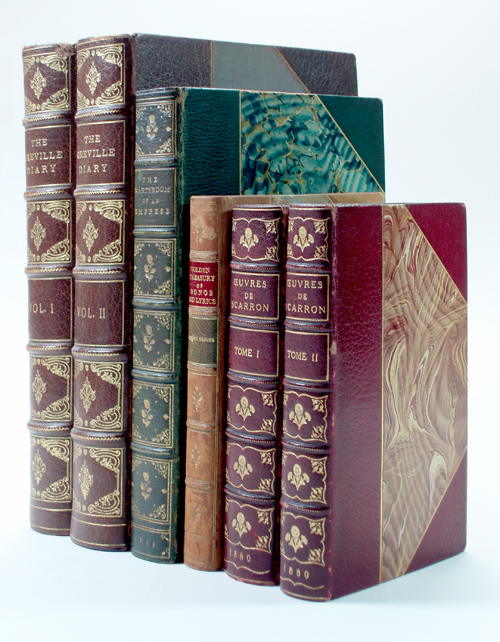
Some banged-up examples of typical Half and Three-Quarter leather bindings by Stikeman & Co, NY. © Jeff Stikeman
These volumes were the first Stikeman bindings I ever purchased, and sat inches apart from each other on a single shelf on the upper floor of Ken Gloss’s Brattle Bookshop in Boston. They’d likely come from a single collection purchase en bloc, which would explain their proximity to each other.
I had learned about the Stikeman bindery out of the blue, at a book fair, and because the name is unique to my immediate family (and a handful of cousins in Canada), I was still in a bit of shock. Who was this ‘Stikeman’. More on that later. …likely much later. I’m working on a history of the bindery, and hope to eventually publish something about their place in the history of binding in America.
But back to the collection itself.
By far the most common and least expensive (both when originally executed, and when purchased today) are the half- or three-quarter leather bindings. Content aside, the bindings are relatively affordable. A paradox here is that although there are vastly more of these types of bindings on the market than there are the full-leather high end extra-gilt versions, the latter are usually in much better shape. The more common bindings are more likely to be kicked around, and so I actually see very few three-quarter or half-leather bindings in pristine shape despite their overwhelming numbers. Those three-quarter bindings that are in fine shape are usually part of a set, many of which seem to have sat on shelves unopened since the day they were bound.
My first purchases were humble bindings, dinged up, but enough to give me the bug. I had come to the Brattle after my shock of discovering (as a book-lover) that there was a binder in the family’s history. Not knowing what to look for, I needed to look at virtually every book to find them. Take one down, open it up, look for a binder’s signature. Repeat a few hundred times.
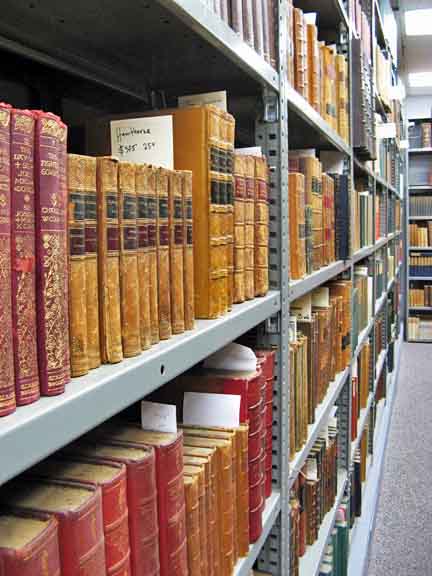
Top Floor, Rare Book Room, at the Brattle. (photo with permission and courtesy of the Brattle Book Shop, Boston)
The Greville set is three-quarter in buckram (a waxed or impregnated linen of sorts), the rest have marbled (paper) boards. For Stikeman, the buckram is more common, generally. Very generally, marbled boards appear usually only on books published in (or whose subjects concern) Continental Europe. The general pattern is that the fillets or rules on the boards are somewhat thick and there is only one single rule. There are only a few Stikeman examples of marbled boards without the gilt rules, and fewer where the rule is a double one. The majority are buckram with a single gilt rule. All of the bindings above exhibit rubbed hinges and some chipping. Not terribly desirable examples, but they hold a special spot in the collection since they represent my first plunge into collecting Stikeman & Co.
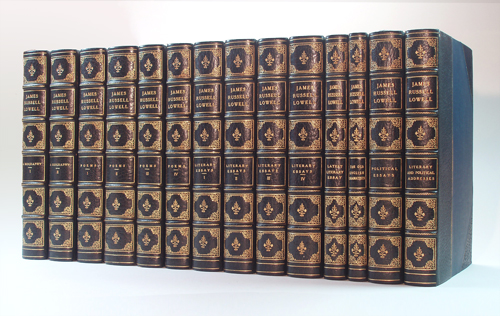
James Russell Lowell “The Complete Works”; 1890 The Riverside Press, Cambridge, 8vo in three-quarter Deep Blue Crushed Morocco and Blue Buckram; copy 128 from an edition of 300; Six Panels Spines Extra-gilt © Jeff Stikeman
During its prime, Stikeman & C0. was capable of turning out a stunningly large volume of high quality work. They did the large majority of the special publisher “sets” of the period (for Scribners, Harcourt, Riverside Press, etc.), likely looking upon that type of work as their bread-and-butter. The Lowell Set above was a set I purchased at the Commonwealth Bookstore, on Tremont Street in Boston. Originally published in ten volumes, four later volumes were issued, and were ultimately bound as one set of fourteen. Stikeman also did full-leather sets. Often an issue was made in three quarter leather, and then a finer edition (extra-illustrated, for example) was offered in a more deluxe binding. It is not uncommon for these deluxe full-leather sets to go for $10-$30,000 these days. My three-quarter set, however, was far less costly. Their condition is virtually as-new.
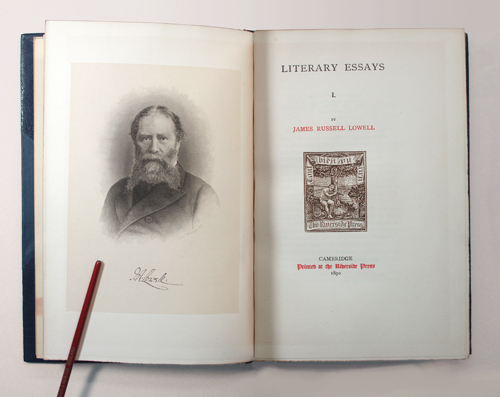
Title Page of the Riverside Press Edition of “The Complete Works of James Russell Lowell”, 1890 (tissue guard digitally removed for clarity) © Jeff Stikeman
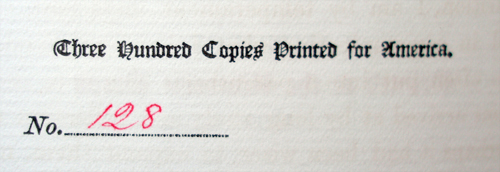
Stikeman & Co. were capable of binding some 300 sets like this, as well as the deluxe set, which would have been a shorter printing and been bound in full leather © Jeff Stikeman
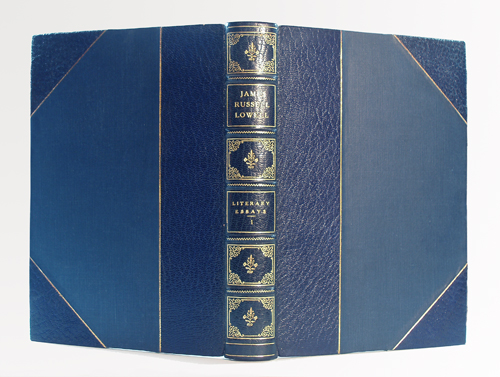
A typical volume in three-quarter leather. The gilt single-rule is almost a certainty in Stikeman’s half and three-quarter work. I have seen only one example of a double rule. Note the slightly convex shape to the volume. It is still stout, flexible, and firm a hundred and twenty years later. © Jeff Stikeman
As similar as these are to other three-quarter bindings from other binders of the period, after looking at so many over the years, I’m now at the point where I can pretty well pick out Stikeman & Co. examples by just viewing the spines on a shelf at arms’ length. This is a great help at fairs, where one dealer may have 500 books for sale. It can be self-limiting, though as I may skip over unusual examples because they don’t fit the pattern, and I only notice those that reaffirm it. Usually though, even just the title lettering alone is enough to make me suspect a book is Stikeman & Co.
Stikeman also produced full-leather deluxe sets. They are a tour-de-force, often exhibiting onlay/inlay work, generally extra-gilt. There were very few binders capable of executing such a sizable volume of work at that quality in turn of the century America, MacDonald and Bradstreet, perhaps. I have only a part of a deluxe set (see Richardson’s “Pamela”, below).
Of all the bindings I have, perhaps the finest, in terms of binding expertise and condition, solidity, etc. is the pair below. For a time, the Bettens family produced a memorial volume (private press) upon the death of each their family members. I have two of what I think are five. Printed on “Japan vellum”, with tissue-guarded photogravures, they are an amazing production. For me though, it is the bindings, in their simplest, stripped down, unadorned “Jansenist” style that really produce the desired effect of solemnity and quiet . There is nowhere to hide. The leather is perfect, construction is solid and expert. The bindings, when shut, still have a slight convex curve to the boards. And it is clear at every detail that the bindings look the way they do simply as a result of their construction, and that the small marks and tell-tale details which remain as artifacts of the binding process are adornment enough. This is a binding. Beyond this, all the gilt and extra work is finishing.
“To be strong-backed and neat bound is the Desideratum of a volume. Magnificence comes after”Charles Lamb, ‘Essays of Elia’
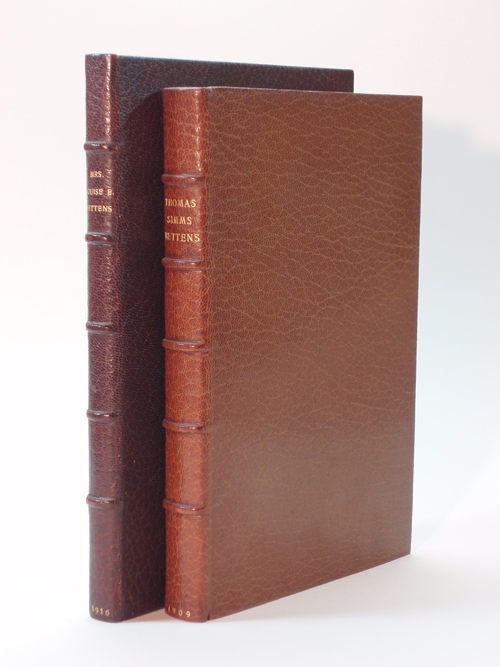
Mrs. Louise B. Bettens and Thomas Simms Bettens; memorial bindings in Full Polished Crushed Morocco, in a Jansenist style © Jeff Stikeman
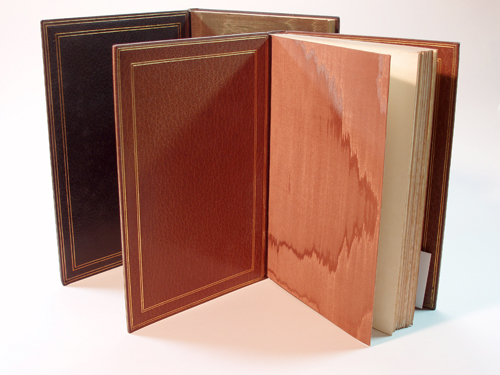
The Bettens memorial volumes, with doublures (or, inner board/covers) in matching Levant (Moroccan goatskin, from a now-extinct species), and Moire’ (“watered”) silk endpapers. © Jeff Stikeman
Here’s a piece that doesn’t quite fit the rest of the bunch. Which is of course why I needed it for the collection. It’s a simple volume, untrimmed with simple paper pasted-downs, in horsehide. It’s not unusual to see a calf binding (well, horsehide actually) blind stamped with onlay titles on the spine, it’s just the Stikeman shop rarely did them. Calf or horsehide is not the wisest of choices if you are concerned with potential condition of the binding under normal use. It wears and scratches easily. Other than the fact that it sits outside their typical style of things, it is an otherwise not too special binding. But it’s in great shape, and it’s enough of an oddity that I had to add it to the collection.

Garrison’s “The New Gulliver”; 1898: 1 of 120 printed at the Marion Press ; 12mo, in brushed horsehide with Dark Brown Title Onlays; © Jeff Stikeman
I think I got it from Tom Boss. I had been in and out of his shop for a few years, buying only one “real” volume in that time (The van Winkle, below). At about a tenth of what the van Winkle went for, it was a cheap enough volume. I felt I need to buy something after taking up so much of his time tire-kicking, and this would fill a niche in the collection, simply by its being unlike all the other pieces.
As far as I can tell, this extra-gilt two-volume set (below) was a rebinding job for its owner, as opposed to a set that was executed for a publisher and sold in a limited edition. I picked these up from Bauman Rare Books, in New York. Housed in custom chemises themselves further protected by slipcases, the set is in virtually new condition, despite being published a hundred years ago. The sunning of the slipcases, to a uniform light brown from green, is testament to the reason for the slip cases in the first place.

G. F. Young’s “The Medici”, NY 1920; in two volumes; 8vo, matching in Full Emerald Green Crushed Morocco, Boards Bordered in Extra-gilt and Extra Wide Panel Borders, with three Black Oval morocco Onlays each Corner. Spine Panels with Titles in Two panels, others Filled Extra Gilt with Black Morocco Oval Onlays; Fifty-six Onlays in all © Jeff Stikeman
The set is heavily tooled. Although the wide board borders are likely done from a single stamp, they are lined inside and out with fillets, and the outer board edges are traced with a fillet of squared brackets stopped by heavy dots. The raised bands are also filleted with a dotted rule, also stopped by heavy dots.
Note the rough, ungilded edges of the text block. Most times the pages are gilded at top at least, others untrimmed (original deckle edge to the paper leaving ‘wide margins’ as was often preferred at the time). After that, next most common for Stikeman is trimmed and gilded all sides. Still others are left unopened or uncut, the text block bound without separating the pages individually from the larger folded sheet they are printed on. These here had nothing done to them. Because they were rebound from cheaper commercial bindings of publisher’s cloth (presumably), the text block was already trimmed, and to trim it further would have narrowed the already narrow margins unacceptably.
Other volumes of mine are slipcased (Uzanne’s “L’Art…” , the “Trilby”, Lowell’s “Democracy”), not too uncommon when dealing with art bindings, but this set is also protected by chemises which first enclose the volumes before they go into the slipcases.
N.B. (Dec. 2013); This set, among the few in as-new condition which I have handled, is now no longer in my collection. It is in the hands of the fine book dealer David Brass, from whom I received the ‘Elizabethan Songs’ volume, listed here in an update much further down this page.
High Points
Thomas Boss for a while had a shop on Boylston Street, Boston. In that area there were four incredible rare book dealers within walking distance of my day-job (Buddenbrooks, Thomas Boss, Peter Stern, and Bromer’s ), and lunchtimes I would overstay my welcome at all of them, trying to become educated about bindings, Stikeman & Co., and the trade in general. Frankly, I probably wore out my welcome. Tom was a collector of American bindings himself, and had a personal collection that was not a part of his shop inventory. The best and worst thing that could have happened to me as a neophyte collector was to stumble into this shop early on. It was great, because Tom was generous with his time, answering questions and showing me some examples of Stikeman & Co. work that he had for sale, as well as alluding to some in his collection. The down-side, though, was that in being exposed to some of the finest Stikeman & Co. bindings I was to ever see, in literally the first shop I visited, I made the assumption that such bindings abounded and could be had fairly readily. This was pre-internet, so when I walked into a store that had two superb examples for sale, and the owner had two or three more in his own collection, well… I simply took it as a given that museum-quality pieces of the Stikeman Bindery could be found easily. Fifteen years later I rue the fact that I did not pay what it took to get them then, as they are now worth considerably more. They are also now all scattered and squirreled away in other collections. Except this one. I bit the bullet (this was a big purchase at the time, what with a child on the way and a new home recently purchased), and went back to Tom’s shop and bought this volume.
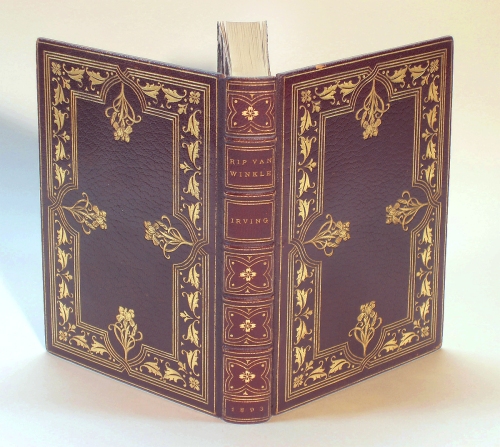
Rip Van Winkle (together with “The Legend of Sleepy Hollow”); An Exhibition Binding by Henry W. Stikeman, ca. 1880-1885 © Jeff Stikeman
An “exhibition binding” is one that was executed as a self-commissioned piece (usually), and which is often over the top in an effort to showcase the skill of the binder and to stand out among his peer’s work. The Grolier Club frequently held exhibitions, as did Charles Scribner’s and Sons, and other New York publishing houses or book clubs. The Rip van Winkle above is not a first edition, and the nature of the text is not necessarily germane to the design of the binding . The book is “all about the binding”. This binding appeared in the November 13th, 1901 Scribner’s Exhibition, and was described in the trade journal ‘The Publisher’s Weekly’ (No. 1555) later that week: “Among American
binders represented are Stikeman, MacDonald, the Club Bindery, and others. Noteworthy in the American examples is a copy of “Rip Van Winkle” in full crimson morocco, with an appropriate design of poppy blossom and leaf.”
The binding has been expertly repaired. The front board had been popped off when, as it was told to me, the book was removed from a shelf in Tom’s collection by an interested but too-relaxed visitor, and dropped. The repair is nearly invisible, but in the tradition of the best conservation work today, it is also readily apparent to the trained eye, not trying to ‘hide’ the repair so much as make it unobtrusive. The spine is very slightly sunned, and there is a minor chip to the upper front board edge. Otherwise fine.
What is important to understand about Henry’s early work, and this is an example probably from a period maybe just a few years before (or while) he took over the Alfred Matthew’s firm, is that the wide borders on the boards are pieced together from individual tools. This was not a monolithically stamped design, as if done with a stamp the size of the board itself. Each leaf or flower device was stamped individually. The Grolieresque intertwining border rules were achieved with curved (“gouge”) rule stamps and mitred rules. The human hand permitting minor enough variances to make it clear that this was done stamp by stamp. Later examples (1910-1920s)also exhibit intricate boards with much gilt ruling and stamping, but these were often done (especially on large multi-volume commercial sets) with a large stamp. See the “History of Art” volumes further below for an example.
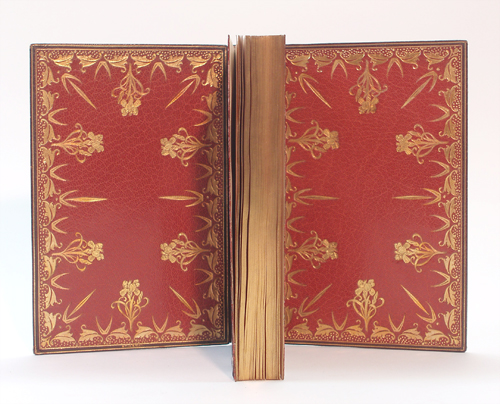
Rip Van Winkle; Inner Doublures in orange-brown Levant, with floral devices and unusual lancets at corners and midpoints along the border. Notice the leaf tool again, repeated from the exterior boards, and pointillzed infill at board edges. © Jeff Stikeman
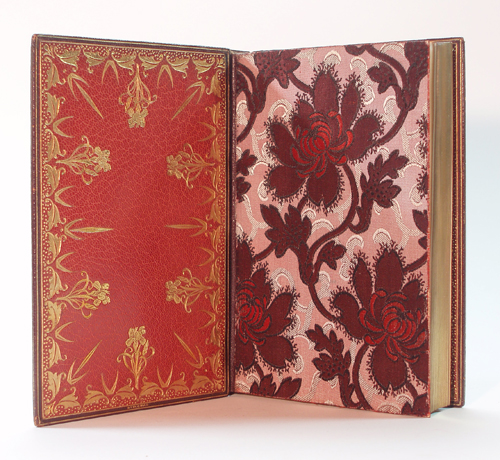
Rip van Winkle; Front inner doublure (left) with the highly unusual (atypical) Front Free End Paper of woven silk. Rear End Paper identical. © Jeff Stikeman
The idiosyncratic nature of Henry’s early work derives almost undoubtedly from his time with Matthews, who in turn was borrowing from an earlier period. Matthews’ work was often made up of very delicate toolings, thin lines, lighter devices, pointillization, etc. All of it making for a heavily worked yet still ‘delicate’ appearance. Where the later work of Stikeman&C0. is often bolder, with heavier (wider) rules, larger and beefier fillet stamps, the early works are lacier and comprise light and very fine work. We can see this in the van Winkle volume above, but perhaps it is all the more evident in the following two volumes, Lowell’s “Democracy” and DeMaurier’s “Trilby”.
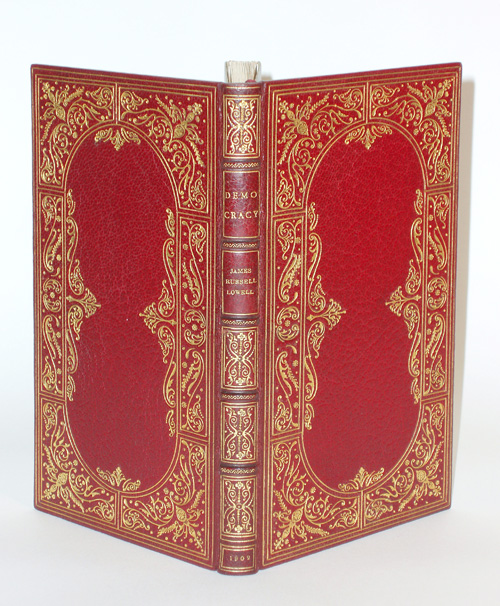
James Russell Lowell; “Democracy”: Riverside Press, Bruce Roger’s edition; Crimson Red Levant with Wide Gilt Panel Borders comprising Floral Device, and Pointille Work, Filling Six Compartments of straight and curved Double Ruling © Jeff Stikeman

Lowell’s “Democracy”; Inner Doublures of Bright Blue, with Scarlet Dentelles (turn ins). Wide border comprising the same and similar Floral tools from the Front Boards, with triple gilt rule at Doublures’ perimeter, and dotted rule at thin Dentelle Edges. Pale Light Blue Watered Silk Endpapers © Jeff Stikeman
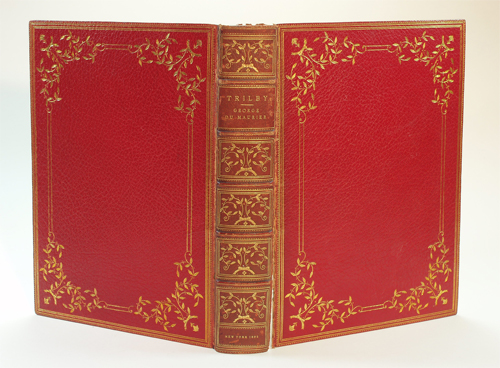
George Du Maurier’s “Trilby”; First Edition Harper Brothers, NY, no. 377 of 600; 1895, The Hall Park McCullough copy with his engraved bookplate on gilt printed vellum front paste down; Large 4to, in Bright Scarlet Morocco (uncrushed), with Large Corner Pieces of foliate Scrolling Rules tied with small Ribbon Tool, Spine Panels Similar; Printed Pastel Floral Endpapers and Rear Pastedown with Wide Gilt Dentelles; Front Board Detached, Rear Threatening. © Jeff Stikeman
In these last two above volumes we can clearly see the influence of William Matthews, the one American binder of note in the mid 1800’s. A designer with whom he worked, Louis J. Rhead, was responsible ( in this Matthews example, below) for the wreaths of willow branches and the design of the stamps and devices.
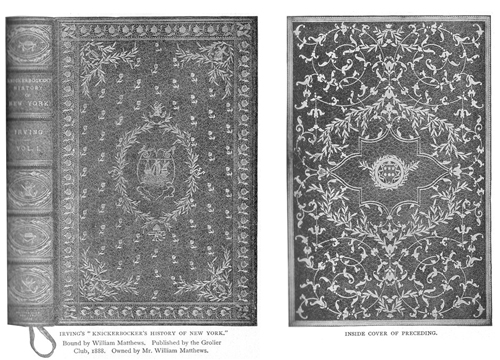
Knickerbocker’s “History of New York” 1888; Bound by William Matthews (self-commissioned, exhibition binding). Not a part of my Collection.
Especially on the inside board (at right) of the Matthews example, it is possible to see where Stikeman developed his early affinity for the leafy delicate scrolls and tracing extra-thin ruling (see the Trilby example). The single-line extra thin rule, which loops about the interior of the board symmetrically, is something that appears somewhat often in Stikeman’s finer work, especially his Grolieresque Bindings for members of the Grolier Club, which I will discuss on another page.
What’s apparent in this American (specifically, New York) work, ca, 1890, is that the binders were a small group, sharing ideas, working together, and intent on creating an American Style. Stikeman and Macdonald both worked at Matthews, Stikeman eventually taking the firm over, MacDonald leaving before then and starting his own firm around 1880. They were operating under the heavy precedent of the great English, French, and German binders, and seemed determined to create something different, yet necessarily responsive and even derived from the tradition. These American Bindings seem to me to be a bit idiosyncratic, self-consciously inventive, and perhaps not as strongly developed as the work on the continent. Still, it was clear that the Americans had something. Writing about a Grolier Club exhibition in “Bookbindings Old and New, Notes of a Booklover” , Brander Matthews asserts that although binding in America was held back not by a lack of artistic talent, but by virtue of the high cost of labor, materials, and tariffs, the “American craftsmen were capable of turning out work of a very high rank. The best of the books bound by Mr. William Matthews, by Mr. Alfred Matthews, by Bradstreets, by Mr. Smith, and by Mr. Stikeman, held their own fairly well. Considering the difficulties under which the art has developed in this country, the showing made by the American binders was the most creditable.”
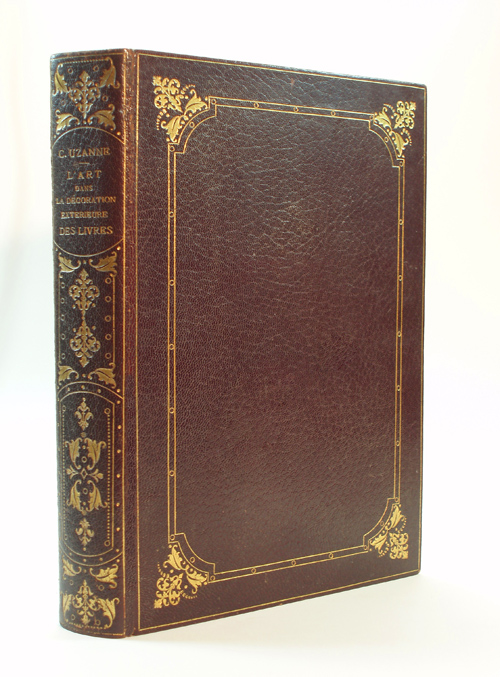
Octave Uzanne’s “L’Art Dans La Decoration Exterieure des Livres en France et a l’Etrange”; 1887; 1 of 500 copies; Large 4to, in Full Plum Crushed Levant, Spine with Bands suppressed and gilt in irregular panels; Front and Rear Boards with large corner devices composed of numerous individual stamps, and an inner double-ruled panel with stepped-in and radiused corners, circlets between the rules. Bookplate of Frank L. Hadley, the American Book Collector © Jeff Stikeman
The Uzanne volume is surprisingly rare. I know of only one other copy available, on the web at least. It is a hefty volume, containing color plates and lithographs of much of the then-modern work being done with regard to bookbinding and exteriors (including commercial cloth bindings). Uzanne was utterly convinced of the superiority of his countrymen’s work, especially that in Paris. The book deals almost entirely with bindings done “on the continent”, but touches (begrudgingly) briefly on the Americans, who get a single page out of some 300 pages. Stikeman gets a mention, and is listed as one among the very few excellent American binders. However, as is often the case even today, his name was misspelled (viz: “Stickemann”). It appears though that Henry took some measure of revenge, by changing Octave’s first initial (on the spine title) from an “O” to a “C”. Touche’, mon frer!
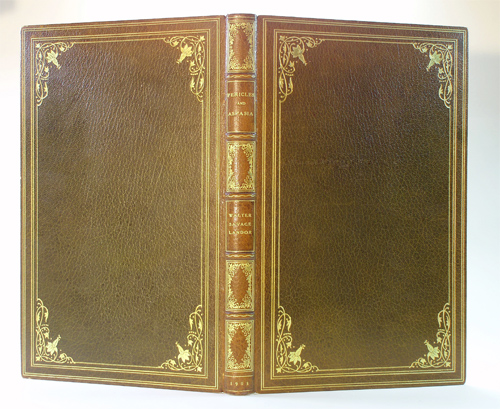
Walter Savage Langdor’s “Pericles and Aspasia”; 1903; 145 of 200 printed at the Chiswick Press, London; Tall Folio in Light Green Crushed Morocco, Extra Gilt Boards and Spine Compartments. Spine lightly Sunned, as is typical with this shade of green, perhaps the most fugitive of the dyes used during the period. © Jeff Stikeman
It is a fairly typical one-off all leather volume by Stikeman and Company. The corner devices are composed of individually stamped tools, rather than from one large corner stamp. The small dots and idiosyncratic composition of the corner devices is more in line with Henry’s earlier work, as compared to the bolder, thicker (ruled) and generally less “delicate” work seen in later bindings. The spine panels are also heavily tooled and composed of numerous smaller stamps. Later volumes might exhibit a single tool in each corner, surrounded by gilt rules. These are built-up in-fill designs from multiple stamps.
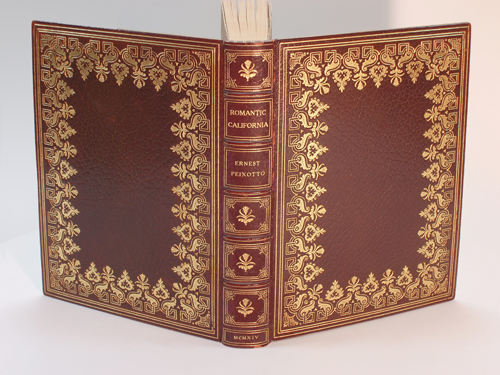
Ernest Piexotto’s “Romantic California”, 8vo, in Full Deep Brown Crushed Morocco; Boards with very wide Borders composed of symmetrical scroll-and-block elements alternating with floral devices. The Spine Panels with same floral tools used also alternating. Double gilt-rules at the board perimeter, and double gilt rules with mitred corner devices in the spine panels. © Jeff Stikeman
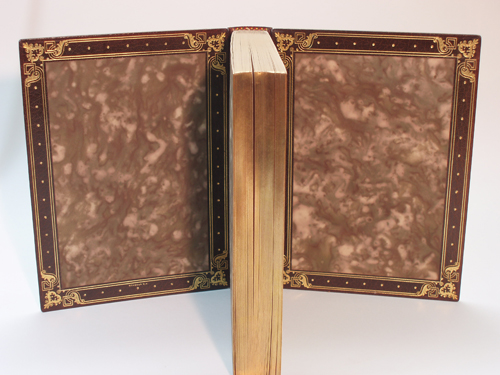
Piexotto’s “Romantic California”; Mottled Brown Fly Leaves with matching Panels on the inner boards; wide dentelles and an inner border at the hinge exhibiting corner pieces composed from the same tools used on the board covers. © Jeff Stikeman
The Piexotto volume above appeared to me at first to have been achieved with a large stamp, embossing the entire board at once. But closer inspection reveals tiny alignment differences, and the alternating floral devices on the boards appear by themselves in the center of the spine panels. It’s clear that the rather wide (and highly successful) borders on the boards are made of individual stamps. Further evidence is that the inner dentelles (where the cover leather is turned in) are stamped, only in the corners, from one half of the typical symmetrical block/scroll device which constitutes the front borders. It’s a beautiful book. The volume is filled with early sketches of California, especially the missions, and is a wonderfully cohesive production. I see no French precedent in the front boards. The inner dentelles are almost ‘western’ in motif. It is essentially Henry being an American, on a volume with an American subject .
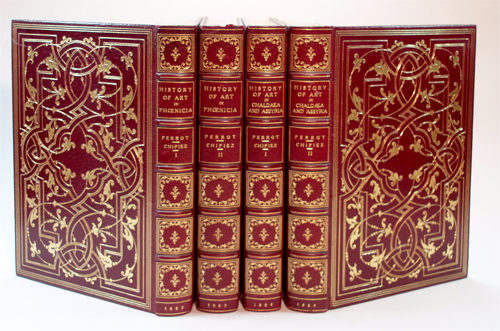
Perrot’s “History of Art in….”: Two Sets of Two Volumes Each in full scarlet crushed Morroco, extra-gilt board and extra-gilt sixpanel spines. © Jeff Stikeman

“The History of Art….” inner boards, with green watered (moire’) silk endpapers and inset inner-board panels; wide dentelles with four widely-spaced gilt rules, and a further double-rule at board edges. © Jeff Stikeman
The Grolieresque boards of “The History of Art in Phoenicia” and “…in Chaldaea and Assyria” are gorgeous, and they certainly had me crossing my fingers that they might have been pieced together from individual tools (these were eBay purchases), but they are monolithically stamped from a large stamp roughly the size of the boards themselves. The gilt rules are later added and make up the difference in size between the larger stamp and the board edges. It’s interesting that the larger stamp seems to have been made from a casting made from a hand-stamped “master” of sorts. There are small human-error variations where the tooling appears to be done individually, but when each board is examined, it is clear that the same variation occurs in the same spot on all eight boards. Unlike a cover made up of multiple individually placed stamps, the gold here acts almost monolithically. Notice how the glare or highlight from being side-lit covers all of the gilding on the side of the board, as though the gilt work is one mirror-like surface, exactly in-plane. When the same type of work is done by hand, the angle of the tool is slightly different with each mark, where the tool tilts one way or another, just enough to make each tool mark shine at a slightly different angle than the next. The tool marks sparkle independently, rather than all at once.
Morris Kalaba, a partner in the Stikeman firm after the turn of the century, held a patent for a device to stamp or emboss a design on an entire board all at once. I do not know if this is an example directly related to that patent. The concept of embossing was not new, however. Publisher’s colorful cloth bindings were similarly embossed in the mid 1800s onward, and the idea of doing the same in leather was likely not entirely original or uncommon.
Here’s a set where the work on the boards was tooled with individual stamps. The full set (which was apparently broken up and sold in parts, a crime which ought to be punishable by death), was twenty volumes. My example numbers five.
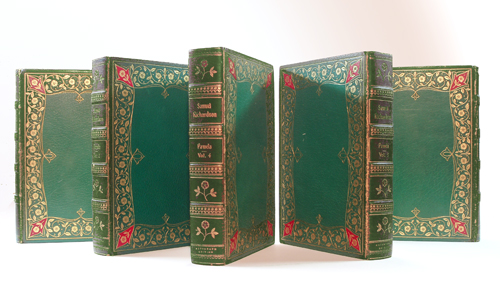
Samuel Richardson; “The Complete Works” in Twenty Volume in Deluxe Bindings, Autograph Edition; From a set of Twenty Volumes, this is the Novel “Pamela” in Five Volumes, 4to, of Full Green Crushed Morroco; Boards of Wide Borders in an Art Nouveau style, four Bright Scarlet Tulipform onlays on each board, and three Red Rose Onlays in the spine compartments (55 onlays in all); Spines sunned, here digitally retouched to approximate the original green. Hinges cracked and starting © Jeff Stikeman
[Note: This has since been edited; I’ve scanned the front and rear boards of one of the ‘Pamela’ volumes, and compared them by superimposing one on the other digitally. It seems clear that the gilt of the front and rear boards was in fact executed with the use of a large board-sized single die, or stamp.]
Elsewhere in this section of the site dedicated to Stikeman and Co., I will post a variant on this binding. Even when executing matching sets for a deluxe issue, Stikeman would alter things, or invert colors. If a set were done in red leather, with green doublures, Stikeman would sometimes do a set in reverse, with green boards and red doublures. Perhaps it was a nod to economy (being frugal with very expensive leather), though “economy” is not the watchword when producing full-leather sets with onlaid leather in contrasting colors, all extra gilt.
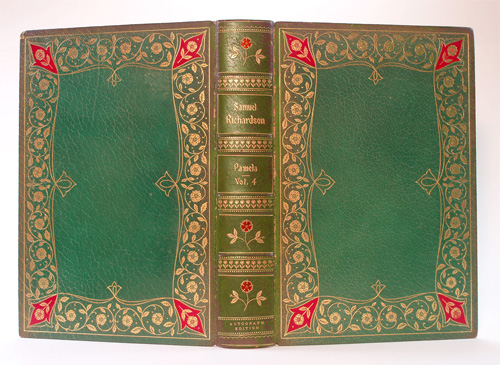
A volume of the “Pamela set, showing the onlaid corner pieces of the boards, and the onlaid roses of the spine. Again, the spine (sunned) has been retouched to approximate the green of the original state. © Jeff Stikeman
Note here the bands of the spine are very broad and shallow, as though sewn on wider cloth tape (as opposed to narrower cords), which they may have been. This is uncommon in Stikeman & Co. work, and here permits a very unusual addition of small flowers to be gilt-stamped along the bands themselves.
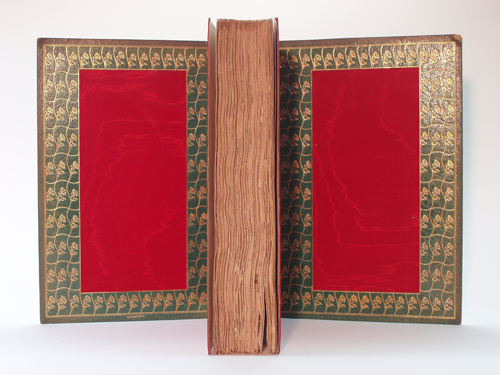
The Unusual inner Boards of the “Pamela” set. The leather from the front boards turns in and stops in the rules which are at the board edges. A second piece of leather fills in the panel, permitting the extra-wide borders, and is further inset with a red silk Moire’ Panel. This gives the illusion of very wide turned-in dentelles with a small ‘doublure’ of red paneled silk. The extensive diaper pattern of curving rules and flowers is again highly unusual in Stikeman & Co.’s work. © Jeff Stikeman
Note the deckled edge of the paper/pages. Many of these “deluxe sets” were left untrimmed, with perhaps the only top edge gilded. Wide margins, extra illustrations, unopened pages, tipped-in letters, author’s signatures… All of these were intended to elevate the publisher’s deluxe binding from that of the lower tiers, and are indicative of the growing American interest in collecting books at the turn of the century.
[Update: Nov 2011]
A mention in issue No.13 of “The Book-Lover” magazine, dated August 1902 describes these very volumes:
Note the cost of the full 20 volume set: $2000. In 1902, a brand new top of the line Packard was $2100. Adjusted for inflation, their cost would be $50,000 dollars in today’s money.
_____________
These three volumes below are large folios, and contain over 1500 engravings published in twelve monthly volumes (bound as three) by the otherwise unknown “A. Raguenet”, of Paris, around 1860-1870. They contain a fantastic wealth of historic information regarding structures all over France, from the medieval period forward, including cathedrals, churches,manses, houses, graveyard structures, and even farm buildings.

A Volume of the Raguenet Folios. © Jeff Stikeman
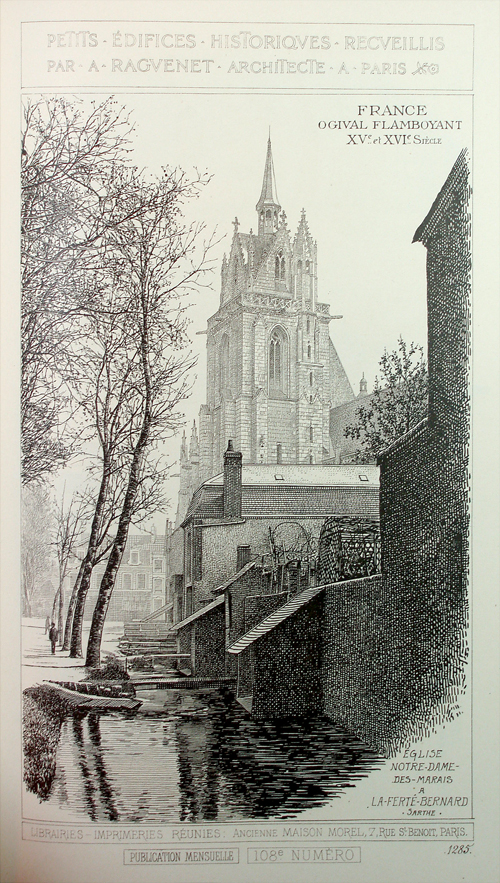
A full-page engraving of Notre Dame des Marais, 15th-16th Century, from Raguenet’s ‘Petits Edifices Historique’, ca. 1870
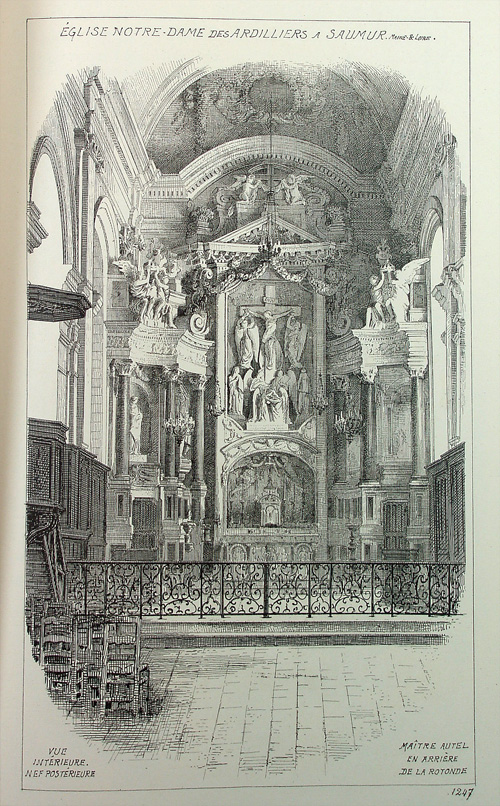
An Interior view. There are more than 1500 such engravings like this, documenting French Architecture in plan, elevation, perspective, and with detail vignettes
The volumes were published fifty years before World War I, and some 70 before World War II, the most destructive war in European history. In both, France lost uncountable historic structures, especially in and around the invasion areas. These volumes record hundreds of structures no longer existing.
In addition to books, I also have an interest in World War II and though I am no historian I do have some familiarity with the subject. I’ve read many books, seen many photographs, and watched many snippets of film recording the war, ecpecially the events concerning D-Day and the invasion of Normandy. I was shocked, then, when I recognized a building in one of the engravings:
After digging through more than a few of my books I stumbled on a photo I had subconsciously stored away: A background building in a photo from Dan Vand Der Vat’s excellent “People’s History of D-Day”, p. 183
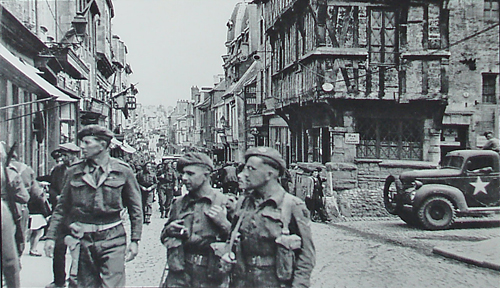
“A street in the Medieval City of Bayeux: June 7, 1944” Note the Bristish Army Officers at left, the American Transport at right
Enlarging to read the street sign…
A bit of Googling…
…and she still stands, 140 years after Raguenet engraved this building for his encyclopedia, lasting through two wars fought literally at her doorstep, and now simply recorded incidentally in a drive down the street by omnipresent Google.
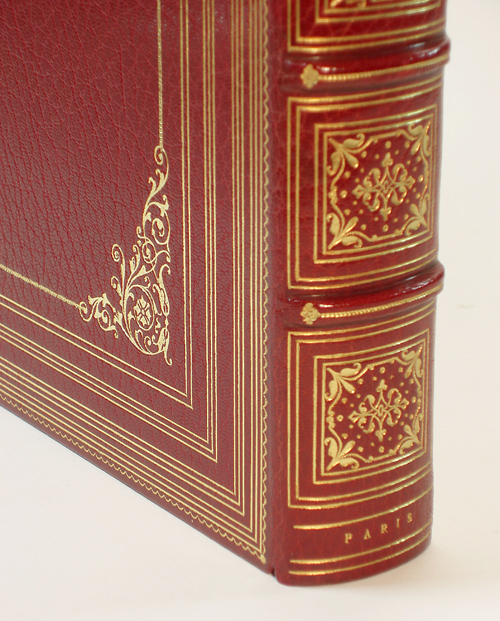
….foot of the spine © Jeff Stikeman
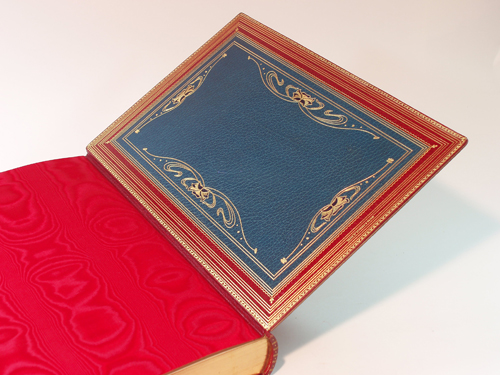
Typical Inner Board (of six) from the “Petites Edifices Historiques” set, showing the striking Blue Doublure with Art Nouveau scrolls and Black Onlay Devices (24 in all); Red Moire’ Silk Endpapers © Jeff Stikeman
_____________
Perhaps the most custom production in the collection is this folio (below), standing about sixteen inches tall, in full green morocco. It is an “armorial” binding, done for a private press edition of a history of the Sayles, Dorr, and allied (related) families. Copies in wrappers may be found on the web easily enough, and I do not know how many of these deluxe versions were done up as a part of the production. In order to produce the coats of armor on the two boards, custom carved stamps were created for the griffins’ heads, tudor roses, ribboned mottos, quatrefoils, and scrolls. The onlaid coats of armor are done in black crushed morroco, with silver leaf and gilt.
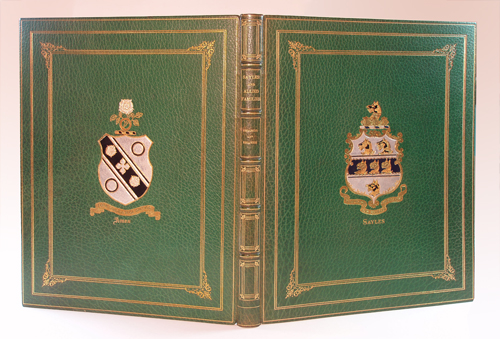
An Armorial Binding for the Large Folio “Sayles and Allied Families”; Prepared and privately printed for Mary Dorr (nee Ames) Sayles © Jeff Stikeman

Front Board, with the Sayles Family Coat of Arms, about Four Inches Tall, in Black Morocco Onlays with Silver Leaf and Gold. © Jeff Stikeman
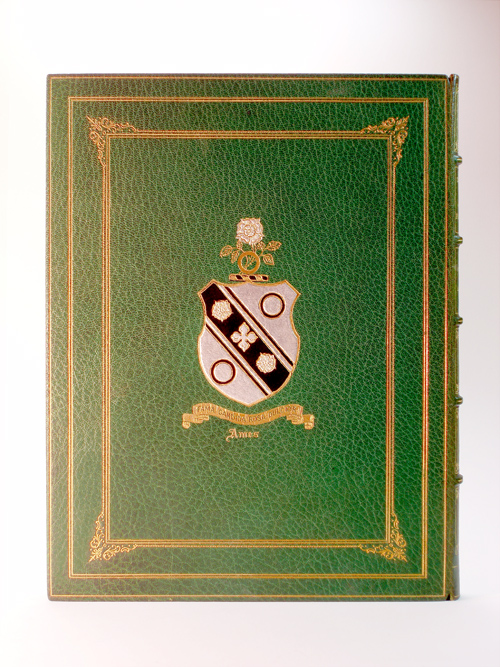
Rear Board, with the Ames Family Coat of Arms, also Four Inches Tall, in Black Crushed Morocco with Silver Leaf and Gold © Jeff Stikeman
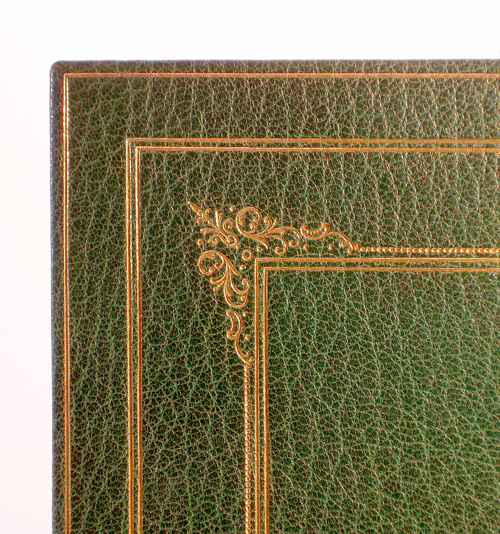
…a typical corner device from the boards. This corner tooling reflects the earlier tendency of Stikeman to build up his corner devices from a small stable of stamps, interspersed with dots and circlets, rather than to use one large stamp (as later bindings more typically show). © Jeff Stikeman
This photograph provides a beautiful look at the grain of the leather. Stikeman used, almost exclusively, a goat’s leather from the Near East (hence the term “Levant” ) which is interchangeably, though probably incorrectly, also referred to as “Morocco”. Morocco is actually a subspecies of Levant. The distinction is due partly to the type of tannins used in producing the leather. Today, Morocco seems to be the term used most often, whether it is technically ‘Morocco” Levant or not. Suffice it to say, the grain is what we care about here, and thankfully whether the correct term is used or not, the difference between contemporary leather and the leather of a hundred years ago is blatantly obvious. The goats from which this came a hundred years ago are (I understand, anyway) now extinct. Today’s bookbinding leather comes primarily from Northwestern or Southern Africa (making it “Niger”), and isn’t nearly as beautiful. The dyes today are very opaque, also. Leather available now has no depth what so ever, as if the color lies on top. Here, the leather is actually stained to its depth, and you can see variation in the color of the grain. Even the best of today’s leather looks like embossed vinyl.

On the Left, true Morocco Goatskin with Vegetable Dye; on the right, Modern Leather with a more opaque synthetic “Stain”

The Inner Boards, in Deep Brown, with a Floral Spray of Pink Onlays, at the inner Front Board. White Moire’/Watered Silk Endpapers. © Jeff Stikeman
The dentelles and their corner quatrefoils are similar to those of “The Medici”, above. The binding is unsigned.
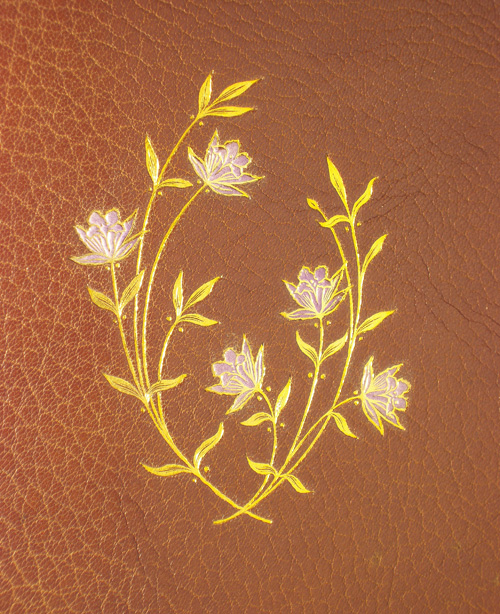
Detail of the Inner Front Board Floral Spray, comprising Long Curved Stems from Gouges, Dots, Leaves and Pink Thistle Onlays © Jeff Stikeman
The added freehand dots are also very typical of earlier Stikeman work, and this photograph again provides a nice closeup of the leather used. In this case, the leather is very slightly “crushed” , where the raise pebbly grain of the leather has been suppressed a bit. Refer back to the “Bettens” volumes, and you will see a more heavily crushed or flattened example, which has also been (bone?)-polished. In the best of the work, the tooling, as extensive as it is, is never done with an eye to obscure the leather.
In Progress
The collection is growing, slowly. I may eventually do a page on those that “got away”. Early on I encountered examples whose kind I have yet to see again. I let them go because I knew little, the prices seemed high (little did i know…), and they seemed to fall into my lap whenever I asked for them. I figured there were more out there, to be stumbled upon fairly easily. Such is not the case… As I add books, I will add to this page.
-Update-
January 2010 :: Milton’s Poetical Works
In the fall of 2009, I was asked by Jeff Weber (in a comment to this page) whether I had ever encountered a Stikeman & Co. binding with a fore-edge painting signed by M. (Morris) Kalaba. Jeff is writing a book about fore-edge paintings, and had discovered a description of a binding formerly in the William Randolph Hearst collection (sold at his death) which mentioned a fore-edge painting on a binding by Stikeman. After nearly twenty years of looking at every Stikeman binding I could find, my answer to Jeff was an emphatic ‘no’. I have never seen an example. …three months later, I stumbled on one.
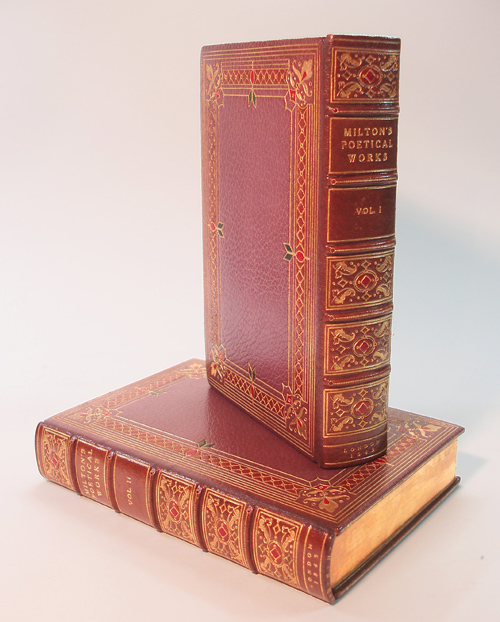
John Milton’s “Poetical Works” in Two Volumes, 1843, Tilt & Bogue of Fleet Street, Publishers; with 120 Engravings by Thompson et al after Drawings by William Harvey; Binding by Stikeman & Co. in full Mauve Crushed Moroccan Leather, with 224 onlays in Red and Green; Fore-edge Paintings signed “M. Kalaba 1919” © Jeff Stikeman
They were produced (if we may date them by the dates on the fore-edge paintings) just as or just after Henry Stikeman retired from the art bookbinding profession. He had been binding for over 30 years, starting under William Matthews, and was president of Stikeman & Co. since founding it in1887. This pair of bindings was produced in the first year with Morris Kalaba at the helm.
They are wonderful examples of post war (WWI) , pre-depression American bindings, and carry the bookplate (oddly slapped on the front doublures) of James Augustine Farrell, President of U.S. Steel, and the first businessman to build a billion-dollar company. They were not inexpensive to produce.
The spines, boards, and inner boards (doublures) are sprinkled with 200+ onlays of red and green. In keeping with Stikeman’s penchant for showcasing the leather, the gilt and onlay work is relegated to borders, with large open panels of crushed Moroccan leather in deep mauve.
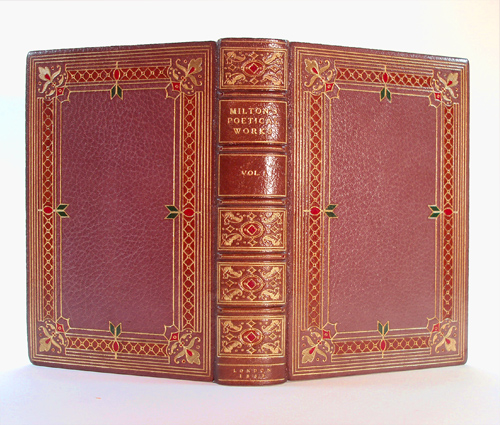
The Boards of Volume 1, John Milton’s “Poetical Works” 1843, in an inlaid binding by Stikeman & Co. 1919 © Jeff Stikeman
The onlays work to unify the design rather than stand out from it.
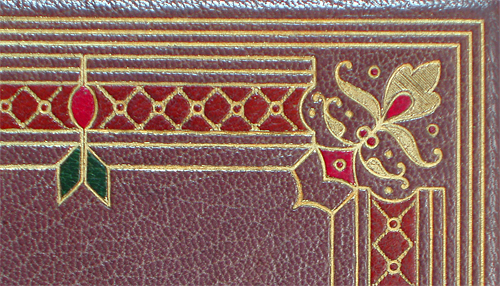
The Corner Device is made up of Six Onlays, the center Dart is made of Three. The “X’s” which form the Running Border occur on a wide Onlay of Rust-Orange, Two per Corner. There are Sixteen Corners in all on the Outer Boards, each with Eleven Onlays, totaling 176 Onlays for the Boards alone. © Jeff Stikeman
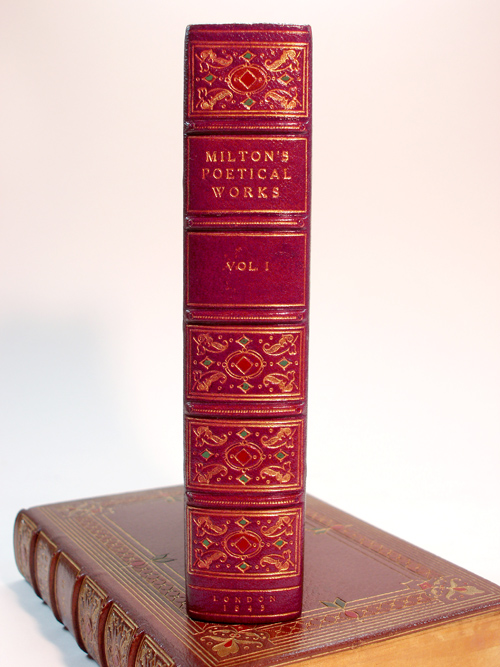
Spine, Volume 1, Milton’s “Poetical Works”, with multiple Onlays in Scarlet, Green, and Rust, within the Spine Panels and on the Raised Bands © Jeff Stikeman
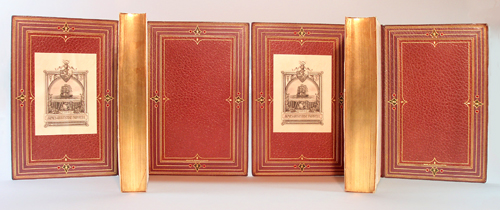
Boards, Doublures of Rust-Orange Morocco, wide turn-ins of Deep Mauve, with Scarlet and Deep Green Onlays; with the Bookplates of James Augustine Farrell, President, U.S. Steel © Jeff Stikeman
The fore-edge paintings, signed “M. Kalaba 1919”, are taken from illustrations in the text. There may very well be examples dated earlier. But the Hearst example also dates from 1919. Still, they are highly unusual, and exceptionally rare on a Stikeman & Co. binding, even a later period binding. They must be noted, and for that reason, I decided I needed to add them to the collection.

Fore-edge Painting, signed “M. Kalaba 1919”, Showing Eve, Prostrate at the feet of Adam, from an Illustration in “Paradise Lost”, John Milton’s Poetical works, Tilt and Bogue edition, 1843 © Jeff Stikeman
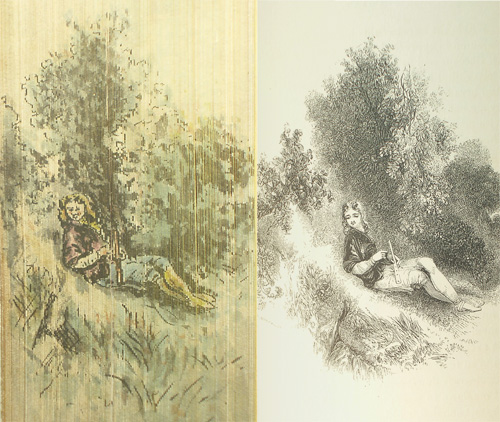
Comus, Recumbent, from Fore-Edge of Vol. 2; Milton’s “Comus” was a Masque printed anonymously, in 1634 © Jeff Stikeman
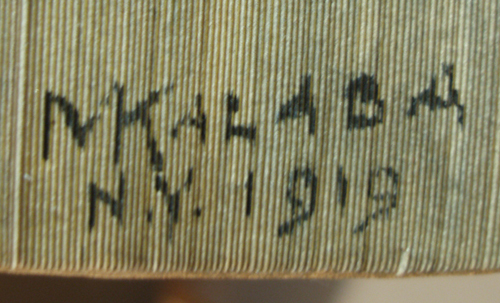
One of the Fore-edge painting signatures; “MKalaba N.Y. 1919”; Note that the last vertical Stroke of the “M” is used as the initial vertical stroke of the “K” © Jeff Stikeman
The text block of both volumes is gilded on all edges. Edge gilding protects the leaves from dust infiltration and oxidation. When a fore-edge painting is present, the gilding entirely hides it, making it impossible to see when the book is closed. Only when opened can one see the hint of an image. Viewing a fore-edge painting requires some inelegant man-handling of the text, especially in small 8vo volumes like these. Kalaba’s paintings here seem sketchier, rather than highly formal. It will be interesting if any more are encountered whether they are similar, or more finely executed.
The volumes were purchase from David Eastwood, of Exeter, Devon, England. At present they define the latest period in my collection of Stikeman & Co. work, although the firm was in operation late into the 1930’s.
-Update-
February 2010 :: A Matched Pair of Derome Bindings
Between you and me, the whole “February” thing is a bit of a white lie. I got these in January too, about a week after the Milton set above. If my wife knew I was buying four books a month, she’d kill me. After a bit of a delay, they were delivered the 3rd of February, which is close enough for me. So, “February” it is then. >cough< Well, what she doesn’t know, won’t hurt her me.
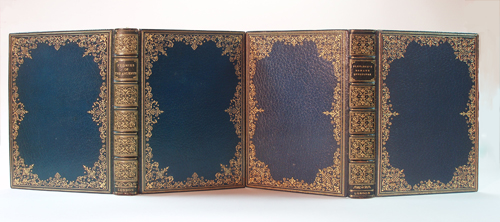
Tyson’s “Pygmies of the Ancients”, 1894 and Plutarch’s “Romane Questions”, 1892; Matched Pair of Derome Bindings in crushed Blue Morocco; signed ‘Stikeman’ and ‘Stikeman& Co.’, respectively © Jeff Stikeman
This pair of books is not quite a “set”. They are matched, and appear at first glance to be identical, but they were bound perhaps two years apart, and are very different on closer inspection. The likely scenario is that an owner had the first volume bound, in 1892, and then returned with another volume from the series when it was published in1894 and had it bound similarly. They are both in the style of Nicolas Denis Derome.
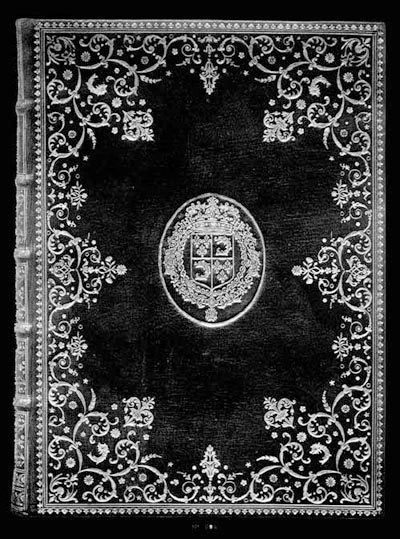
A Derome Binding, “Les Adventures de Telemaque, Fils d’Ulysse”, 1783; 4to, signed “Derome le jeune”; This binding Exhibits the typical foliate or ironwork border of multiple tool impressions; this binding is roughly twice the size of the Stikeman examples above
Derome developed a technique where a small number of individual tools (scrolls, dots, stars fillets, quatrefoils, etc.) were used repeatedly, over and over hundreds of times, to build up a wide foliate border while leaving a broad center panel. The style of Derome permits infinite invention in the variation of pattern from just a relatively small number of stamps. Where in later years Morris Kalaba would speed Stikeman & Co.’s production by embossing the boards in one move with a large board-sized stamp, here Stikeman is making literally hundreds of individual impressions. The effect is phenomenal. Two years later, the second binding was executed in the same color, with the wide border leaving a center panel in the same rough shape as the previous, yet using different tools in different patterns.
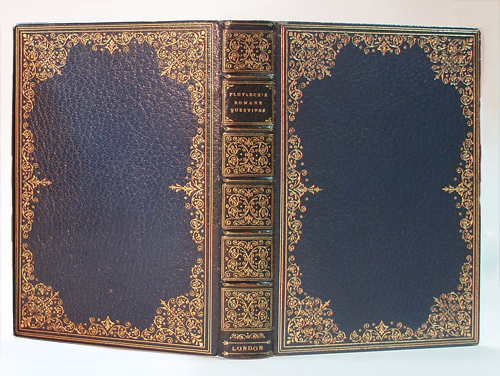
Plutarch’s “Romane Questions”, 1892, in a Derome Binding by Stikeman & Co.; small 8vo, about 5×7.5 inches © Jeff Stikeman
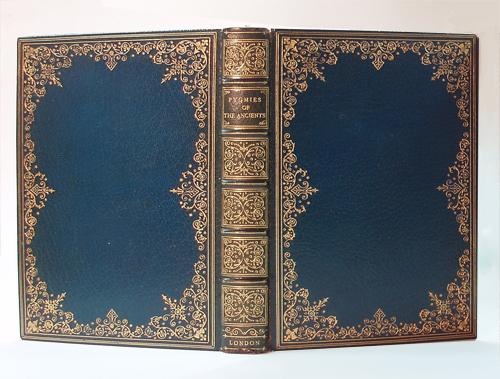
Tyson’s “Pygmies of the Ancients”, 1894; A Derome style Binding by Henry Stikeman; small 8vo, about 5×7.5 inches © Jeff Stikeman
Here’s an enlargement of a typical corner/quarter of the board panel for each volume. At top is the 1892 volume, at bottom, the 1894. I roughly count 50 to 60 individual impressions for each corner, meaning that the boards alone for each volume are built up of 400 or so individual tool impressions. The scale of the tools, their delicacy, and their fineness all fit with Henry’s earlier work. These are about five years into the establishment of Stikeman & Co., and about the time he was preparing for the World’s Columbian Exhibition.
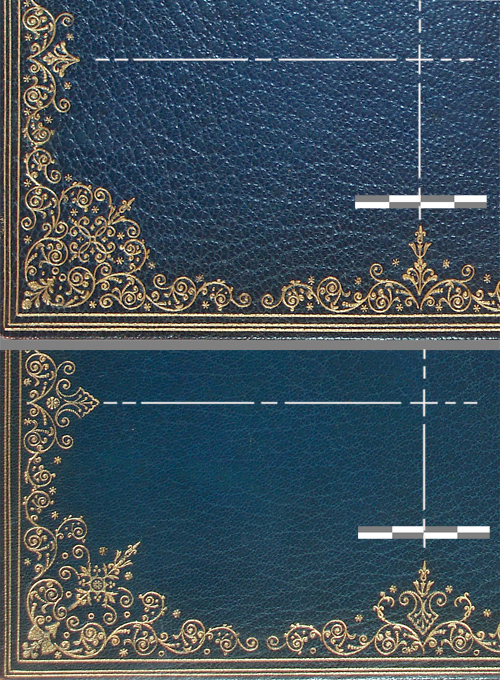
Comparison of the two front boards. The dashed lines are the centerlines of the front boards. The checkered index represents one inch, divided into quarters. © Jeff Stikeman
The earlier volume at top is done in a blue Moroccan leather that has been only slightly crushed or flattened. The later volume is in the same blue, but the leather is smoother and more highly crushed.
The spines of both were handled similarly, with the same tools used on both volumes, only spaced more closely together on account of the narrower spine of the second. At the middle top and bottom of each of the narrower spine panels, a smaller tool was substituted for the longer scroll of the first (wider) volume, which would not have fit. Otherwise they are essentially handled the same. There were nearly 200 individual tool impressions required for the spine of each volume.
The inner boards have fairly wide dentelles (turn-ins), including along the gutter (hinge). Each curl, scroll, dot, asterisk, fleuron, or dart represents a single tool impression.
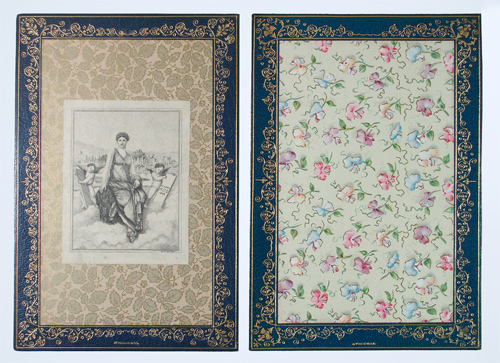
Inner Boards/Dentelles of “The Romane Questions” 1892 at left, with “Pygmies of the Ancients” 1894 at right; The Plutarch volume bears a copper-engraved bookplate by Wm. Fowler Hopson, the New Haven artist and engraver; it reads “Ex Libris N. J. D. , 1900”, and was one of only four that Hopson executed that year, from a hundred in his lifetime. The boards have been paired here digitally. © Jeff Stikeman
There are some 150-160 stamps for each board’s inner dentelle, say 300 per volume for the dentelles alone. Note the pasted paper inserts (with matching endpapers). The insert and endpapers of the right volume are the same used in the “Trilby” volume, mentioned earlier on this page.
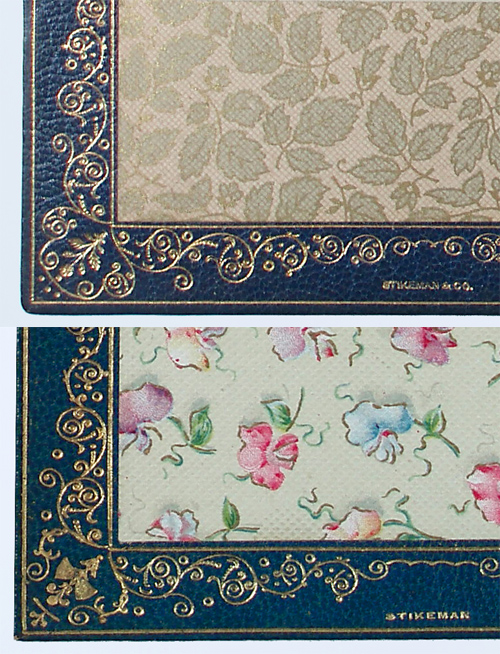
An Enlarged View of the Inner Dentelles Corners; note that the later volume is signed “Stikeman” and the earlier is “Stikeman&Co.” © Jeff Stikeman
Tooling in the manner of Derome requires great skill, as the work is done without a cartoon or pattern, freehand. Edith Diehl taught that normally a finisher (who applies the gilt tooling) would often blind-in the mark (with no gilt, making just the impression) through a paper pattern taped to the leather as a guide. Then he would remove the pattern, reapply the same mark this time with gilt, then come back again a third time (either with more gilt or without), in order to polish the gold. But a highly experienced finisher however, according to Douglas Cockerell in his “Bookbinding and the Care of Books”, 1902, could accomplish the work without a pattern to guide him. The finisher merely followed a general pattern marked up on the boards denoting centers, layout lines, etc. and followed them freehand, filling in as required. No ordinary finisher would have blinded these stamps, gilded them, and polished them a third time. They were executed in one pass. Tooled in this way, they still required nearly 2000 total individual tool impressions to complete.
-Update-
April 2011::An Early Stikeman Paneled Binding
This arrived at the beginning of April from the book dealer Richard Aaron of “Am Here Books”, near Springfield, Illinois. Richard is handling the sale of the Gerald M. Goldberg Collection of Oliver Goldsmith’s Works and related materials. This is a first edition from that collection, Goldsmith’s “The Traveller: or a Prospect of Society”, from the 1765 J. Newbery printing in St. Paul’s Church-Yard, London.
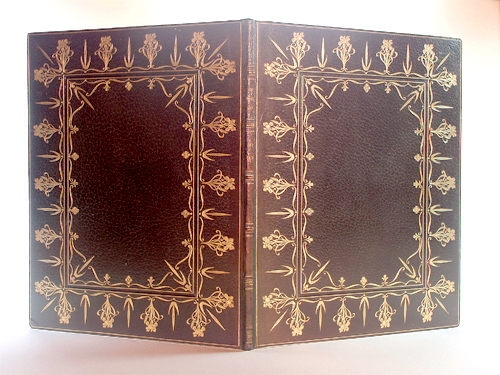
Oliver Goldsmith’s “The Traveller: or a Prospect of Society”, 1765; 4to (about 9×12) in Black Morocco with gilt stamp decorations to boards and inner dentelles, by the New York binder Henry Stikeman, executed ca. 1892
It’s what’s called a ‘paneled’ binding (a border around an open inner rectangular panel), and the design is startling.
An inner rectangular deeply blind-stamped thick fillet forms the inner panel, which is ruled in gilt by thin fillets again, and then bordered each side by dots and individual scrolls. Outside that, large floral stamps, with lots of black breathing space between them, run around the boards in an equal rhythm pierced by graphic, long sharp needle-like darts. The inner panel border is of smaller tools, with the same needles used diagonally at the inner corners. The scale is quite large, and the effect is a cross between a traditional Roger Payne binding, and something from the English Arts and Crafts.
This binding shares about 6 stamps with another binding in my collection, the Rip Van Winkle described already, a good bit further up the page. Young binders do not have as many tools in their stable, and we see Henry here developing a pattern and design which is wholly different from the other, yet comprises mostly the same tools.
A more direct comparison below, board to board, shows the tools used on the covers more clearly. The lancets or darts on the covers of the larger binding were also used on the interior of the Van Winkle, which can be seen in the previous photographs of that volume.
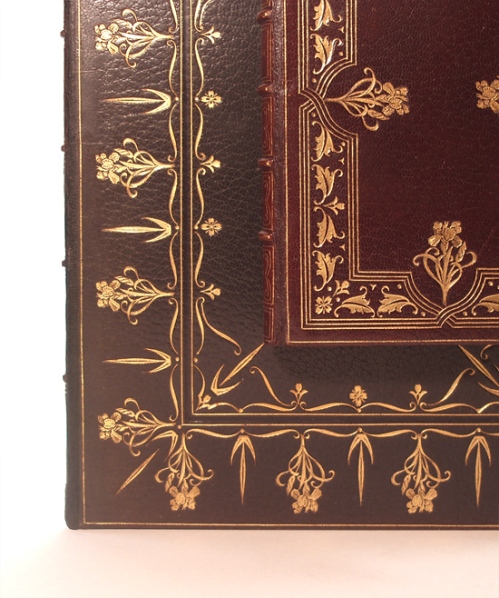
A Comparison of the tools used on the “Traveller” and “Van Winkle” bindings; New York bindings by Henry Stikeman, ca. 1892
The inner boards of the “Traveller” are marbled paper, and the leather from the front returns inside as narrow tooled dentelles . An interesting tool to note here is the small bud at the very corner. It appears on other Stikeman bindings of this early period, specifically the Grolieresque binding below, and two other very similar variants. On a lesser note, the marbled paper of the inner boards is from the same batch as that in the Octave Uzanne volume mentioned earlier, which also shares a few stamps with the Van Winkle. They all date from the same early period in the firms’ work.
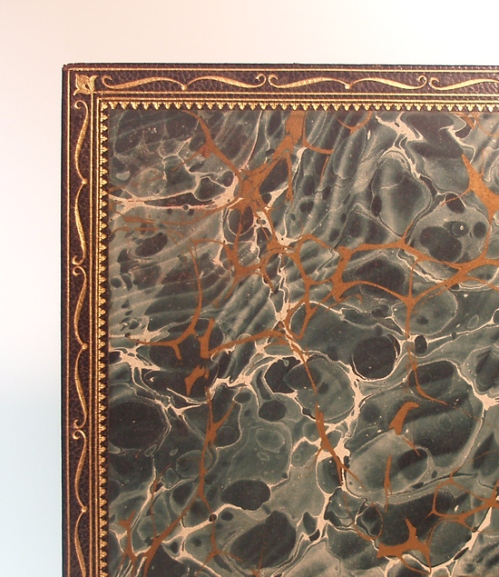
Inner Dentelles of “The Traveller”, in a border of shallow scrolls of the same tools from the front/rear boards, and a small corner tool, used in other bindings of the period.
These two volumes taken together are, to me, what the finishing (gilt work) on a binding should represent: a pattern developed from repeating tools, applied one at a time by the binder/finisher. Each tool mark was first blinded-in, to establish the pattern in the leather without any gold at all. Then gold leaf was laid down and another impression made to set the gold. Often, a third tooling was required to fill in bits of missing gold, or to polish the design. It is labor-intensive, and is why to me Henry’s earliest bindings are so much more important, before the decline of the level of execution began under later management, prior to the dissolution in 1932. In my opinion, this binding is from very early in his career, about five years out from his taking over the Matthews’ Bindery .
-Update-
November 2011:: A Miniature Gem, Collection of
Samuel P. Avery, President of the Grolier Club
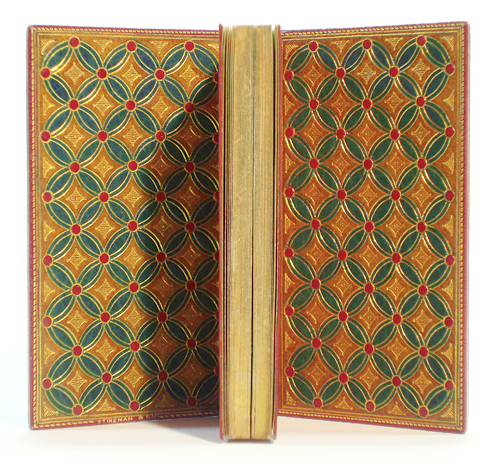
‘Catullus, Tibullus, et Propertius’, inner boards, in a miniature binding ca. 1890 by Henry Stikeman
This volume, tucked among 24 others in an otherwise nondescript auction lot described thinly as simply “Lot 44: Classical Literature; Miniature and small-format books”, was part of the June 2011 sale of Rare Books and Manuscripts at Christie’s, New York. Small, hidden, and very rare, it is the definition of a gem…. Measuring just under 1-1/2″ wide and 3″ tall (48vo), printed in famously tiny 4-1/2 point font, this collection of ‘Catullus, Tibullus, et Propertius’ is a miniature from the Pickering “Diamond Classic” series of Imprints, printed 1824. It was bound in 1890 at the latest, by Henry Stikeman.
The binding is an immaculate Jansenist example, plain and reserved on the exterior, but with multi-colored inlaid doublures (inner boards/covers) after the style of Padeloup. It was likely bound for, and was certainly once in the collection of, Samuel Putnam Avery; art dealer, book collector, benefactor, founder of the Metropolitan Museum of Art, and early president of the Grolier Club in New York. Avery had a special interest in miniature books, as well as inlaid bindings. This volume is an important American example of both.
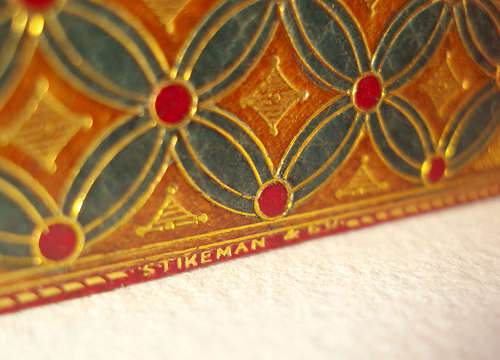
Close-up of the “Stikeman & Co.” binding signature and inlaid Doublure of the inner front board. As reference, the distance between the red dots is less than a half inch.
It dates just three years after Henry Stikeman founded Stikeman & Co. (1887) as successors to the Matthews Bindery, the most important bindery in America to that point. It is an important early binding in the Stikeman firm’s history, having appeared in a number of very early seminal New York bookbinding exhibitions. These first exhibits stoked the desires and imagination of the first serious great binding collectors of the period, and they fomented a frenzy of escalating design and execution during what was arguably the high-point of American bookbinding. They also demonstrated unequivocally that Stikeman and a small handful of American binders were certainly capable of equaling the French work of the same period.
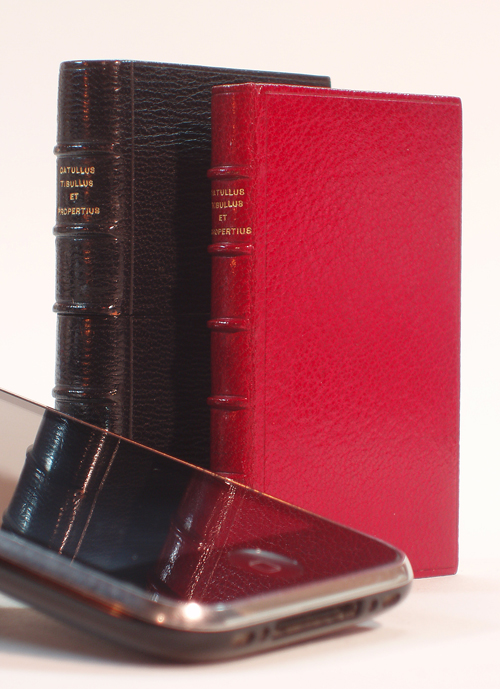
…and with an iPhone for scale. The Binding is about the size of the display screen. Though the iPhone contains many more books, which of these devices will still work in another 120 years?
The binding’s first appearance at exhibition (according to my records) was fittingly at the Grolier Club, in the “Exhibition of Recent Bookbindings, 1860-1890, Executed by American, English, and French Book-Binders”, which ran Christmas Eve, December 1890, to the 12th of January. This was only the second Grolier exhibition dedicated to bindings, and the first following Henry’s establishment of the firm. It would have been the first opportunity for Stikeman to exhibit under his name. His work had previously appeared as the finish work on (some of) Matthews’ bindings.
One of five bindings attributed to Henry Stikeman in the exhibit, four of them heavily inlaid, this appeared as item 193:
Ten years later it appeared in another Grolier Club Exhibition, one dedicated solely to “Mosaic” (or inlaid) bookbindings. The show, entitled simply “Mosaic Bookbindings”, ran from January 23rd through the 22nd of February, 1902. It was one of three inlaid Stikeman bindings in the exhibition, number 249:
It is worth noting that the ‘Cicero’ binding, number 248, appears in these same two catalogues (and yet again in the catalogue of Avery’s collection, see below). It seems to have traveled the first dozen years of its life with the Catullus. They’ve since parted, but I have faith Cicero will turn up again and they will be reunited.
Whether the Catullus (or the Cicero, for that matter) was directly commissioned by Avery we do not know, but it did at one point become part of his famous collection. Samuel Putnam Avery last exhibited this binding in 1903, the year before his death, in the exhibition “Works on Bookbinding: Examples of Bookbinding from the Collection of Samuel Putnam Avery”. Henry bound a number books for Avery (as he also did for many of the members of the Grolier Club) before, during, and after the period of the Club Bindery. Avery seemed especially taken with inlaid bindings, and Stikeman did at least three heavily inlaid bindings for him in the period between 1890 and Avery’s death fourteen years later. One of thirteen Stikeman bindings in the show, it was catalogued at number 233 as follows (note the description of the inner boards/doublures):
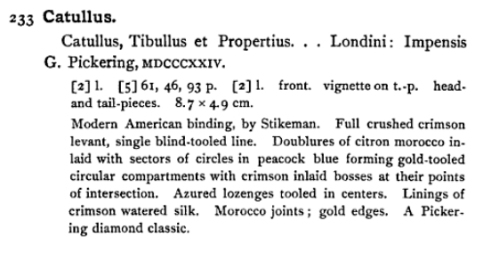
Item No.233 in the Catalogue of the Collection of Samuel Putnam Avery, President of the Grolier Club (1896 – 1900), June 1903
In its earliest catalogue appearance, the binding is referred to as ‘Jansenist’, with the inner boards ‘in the style of Padeloup’. For anyone not familiar, a quick run to Branders Matthews’ famous “Bookbindings Old and New” (1895, NY) to revisit the terms:
“In the reign of Louis XIV, by sheer reaction against the leaden showiness of the fashion set by the king, there arose the simple style of binding called after Jansen. The Jansenists bound their books soberly, with no gilding whatsoever on the sides, relying on the simple beauty of the leather in which their volumes were clad and decorating only the inside.” “These under-decorated books were better bound in a technical sense than those of an earlier day, ….were more solidly prepared, more carefully sewn, more cautiously covered”.
And;
“Shortly after the death of Louis XIV was produced one of the most remarkable bindings in the history of the art. Its chief characteristic is that it is a mosaic – that it has a polychromatic decoration formed by inlaid leathers of various colors. ” It is attributed generally to Nicolas Padeloup, who “found models in ecclesiastical stained-glass“.

The Catullus in its Case, showing the single gilt rule of the board edge, and the single blind (not gilt) rule inset around the edge of the front and rear boards. All edges of the text block gilt and polished.
The condition of the binding is virtually as new, with all spine hubs crisp, corners un-bumped, and leather flawless. Polished Crushed Morocco in crimson red, with citron yellow doublures inlaid in peacock blue and crimson. It was acquired from Phillip J. Pirages, the famed Fine Book and Medieval Manuscript dealer, whose knack for turning up fine bindings is unmatched.
-Update-
May 2013:: Two Items titled “Gothic Architecture”;
one by Pugin and another by William Morris
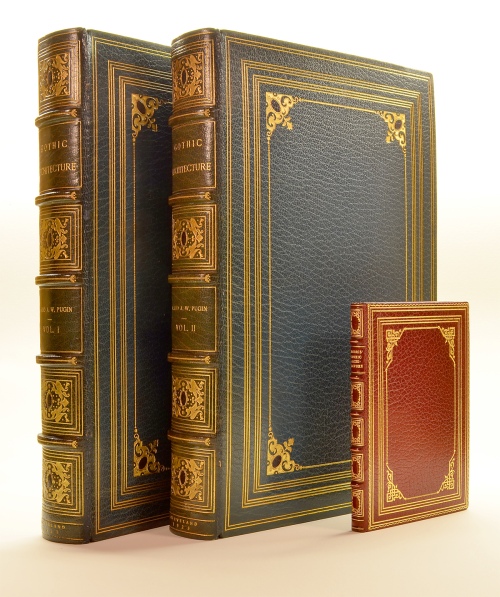
Pugin’s “Gothic Architecture, Selected from Various Ancient Edifices in England” in Two Volumes, published 1923; Together with a pristine 16m0 volume of “Gothic Architecture; A Lecture Given to the Arts and Crafts Society” by William Morris, and printed at the Kelmscott Press, 1893
I recently acquired these three volumes within the same week. Their common subject and title, “Gothic Architecture” is a complete coincidence. Their size differences a happy accident also; Pugin’s in Tall Folios about 12″ tall, and Morris’ Hand-Press piece at only 5-1/2″.
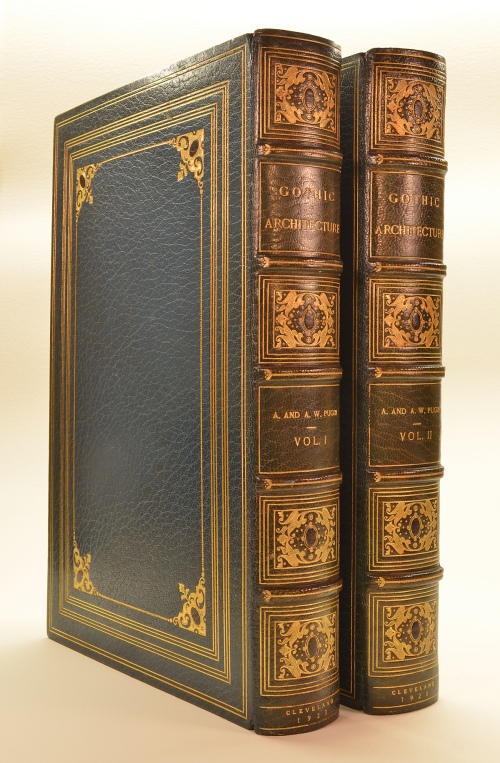
The ‘Pugin’ Bindings are Deep Blue Crushed Morocco, with Onlays (at Board Corners and Spine Compartments) of Black Morocco Ovals and Curls © 2013 Jeff Stikeman
The three-hundred-plus Plates of the Pugin set are printed on very stiff card stock, and as a result, they have been “guarded”, so that they can open wider and turn more easily than they might otherwise (being very stiff). “Guarding” involves creating a continuous linen hinge, more flexible than the paper, between the plate and another narrow strip of similar paper. This narrow strip of paper is then sewn together on cords with the others to make up the text block. These strips form the back of the book, with the plates free to turn on the linen hinge.
The corner devices of the front and rear boards feature subtle purple-black ovals, flanked by small comma-shaped curlicues, also onlaid in black. The corner devices on the bright purple doublures (the inner boards) are architectural in style, gilt (no onlay).
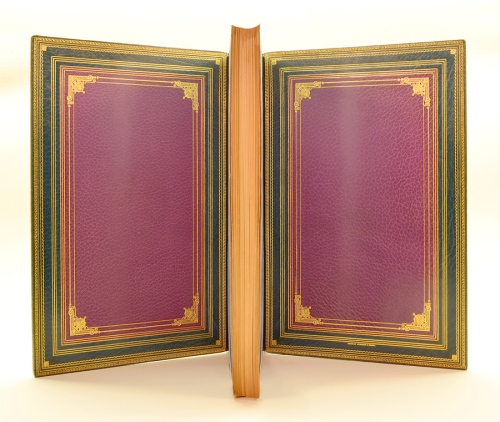
The Pugin Volumes are in Full-Leather, with wide Dentelles matching the Cover Leather, and Doublures in Bright Purple; Spines Slightly Sunned
The set is made up of more than 300 plates depicting plans, sections, elevations, and enlarged details taken from field measurements and surveys conducted by Pugin in the early 1820s-1830s. The plates here were issued loose, in five volumes (here bound into two).
The plates are exacting and to scale, and provide complete dimensions, details, and rotated sections as necessary to record the subject in its entirety. The survey was extensive and exhaustive.
Auguste Pugin was an artist, an architectural draughtsman, and a writer on medieval architecture. His son, with whom he produced this survey, was Augustus Welby Pugin, an architect and the leading advocate of Gothicism in 19th century England. He is most remembered for being the designer of the Palace of Westminster, home of the United Kingdom’s Parliament. The plates may be viewed in their entirety HERE.
In contrast to the size and heft of the Pugin set is a small, thin 16m0 piece in a deep red full-leather crushed-morocco binding. The text is from the famed Kelmscott Press, a transcript of a lecture given by William Morris to the Arts and Crafts Society, also entitled “Gothic Architecture”. It was published two years into the Kelmscott’s life, and was the first piece published by them in 16mo size.

William Morris’ “Gothic Architecture”, in a pristine as-new Stikeman & Co binding, itself housed in a four-fold chemise with matching half-leather slipcase.
Like “The Medici” set well-above, this volume is in as-new condition, well protected by the chemise and slipcase which have held it since being executed.
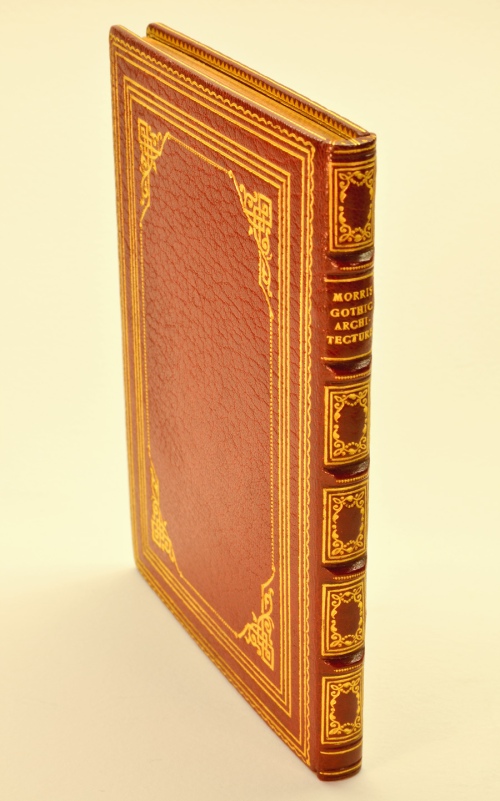
The scale of the binding is deceptive, given the tiny size and crispness of the tooling. It is, in reality, only about 4-1/2″ wide and 5-1/2″ tall”
The inner boards have proportionally wider dentelles than usual, with mottled paper paste downs. The top edge is gilded, but all others untrimmed, with original deckled edges as straight from the press. The style points of the binding put it ca. 1920, based on my experience.
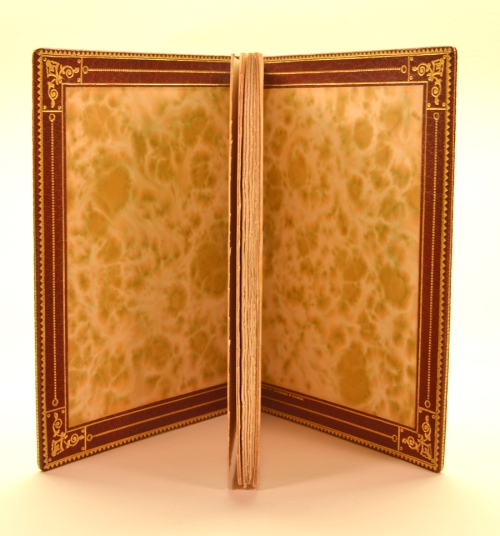
“Gothic Architecture”, with Wide Leather Dentelles and Inner Boards of Mottled Paper. Tools comprise dots, dotted rules, circlets, and corner devices of three separate tools
I’ve said before that I am generally less concerned about the content than I am the binding. The fact that these are both architectural titles and, even further, that they both concern specifically Gothic architecture, has less to do with my profession (as an architectural illustrator) than it does with serendipity. But it’s a happy bit of serendipity. I’ll use any excuse to buy a book that I can get.
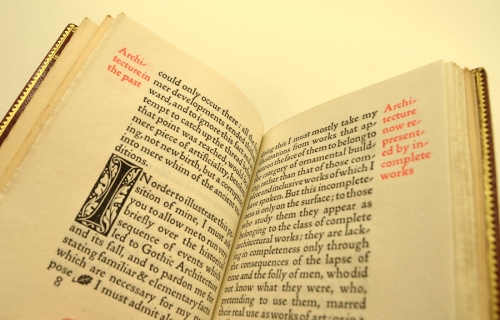
The Text: A Kelmscott Press Production, using their “Golden” Type Style (designed by Morris), with Red Marginals and Woodcut Initials throughout, printed 1893
-Update-
August 2013:: A Privately Printed
Collection of English Verse, 1894
In late July I received an email from a fellow binding collector with whom I correspond occasionally. Often, to be truthful. He, I, and another binding collector trade a good number of emails discussing various binders, techniques, our hidden gems, mistakes, and (with much complaint) rising prices.
He attached a photo he’d copied from a catalogue description he’d seen of a fine binding which he found interesting. The catalogue described it as ‘unsigned’, but he wanted to run it by me, and his question was simply “What do you think? Is it a Stikeman?”
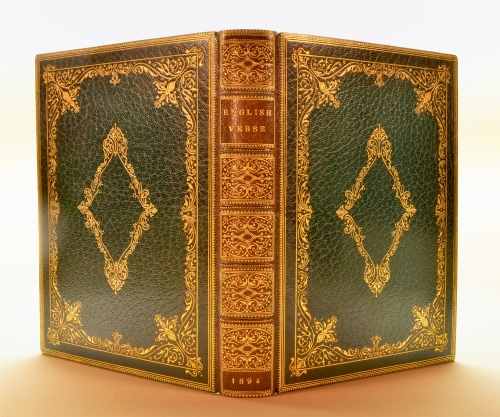
“English Verse, Chiefly Lyrical”, 1894; by Louis Henry Bristol, ed.; Privately Printed By Tuttle, Morehouse & Taylor Press; small 8vo; Bound by Stikeman & Co. NY, ca.1894
I wasn’t sure if he was going to be buying it, or even if it was his already, in-hand. I took a quick look at it, and my heart sank immediately because it was a Stikeman. Assuming that he was buying it or owned it already, that meant I had missed it. I emailed back, admiring his keen eye in spotting ‘Stikeman’ in an unsigned binding, from a single simple photograph. ‘Til that moment, I’d have bet I would be the only one to be able to do that. Many dealers know of Stikeman, and a few collectors, but hardly anyone knows the small differences which constitute a ‘tell’, and give the thing away when it is unsigned.
The tooling was done with numerous small scroll tools, simple gouges, and dots, stars, and circlets. The front and rear boards each have about 200 separate tool impressions, not including the gilt rules and dog’s tooth scroll at the board edges. The spine is fairly heavily wrought, with each of five tooled compartments comprising about 33 individual stamps each. Together with the tooling on the hubs and bordering the compartments, the spine required a further 200+ tool impressions.
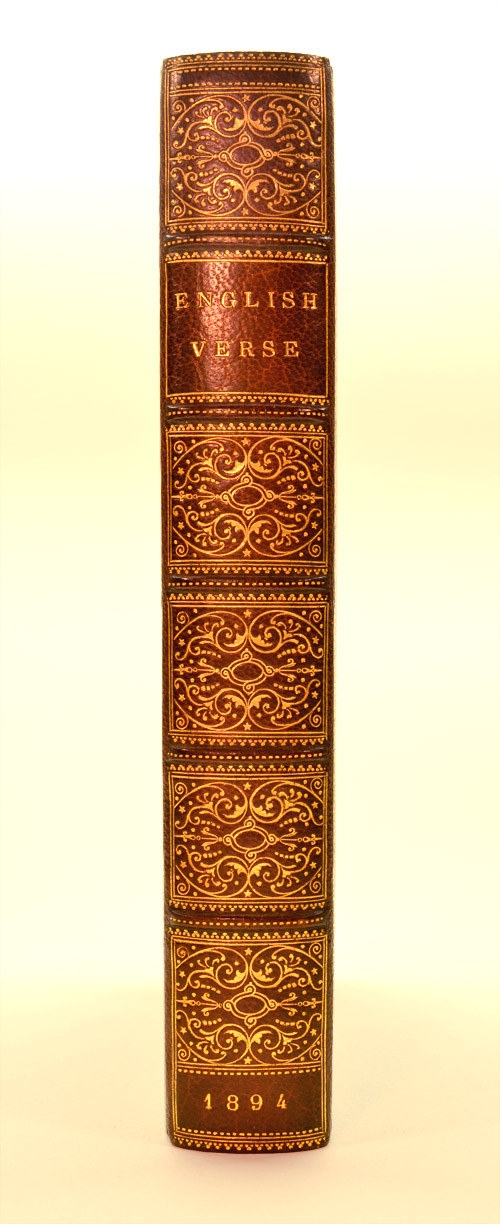
Spine of “English Verse” in Six Compartments; shown here larger than full-size (for reference sake, each compartment is exactly one inch square)
I replied, knowing I missed out on it, that yes, it was a Stikeman binding. I asked whether he’d purchased it already. “No. It’s yours if you want it” he replied, and passed along the dealer’s name. An email later, no questions asked (other than confirming condition), and I bought it, having offered a third less than asking. It arrived in a few days and I turned it over front to back, giving it a quick look. I already knew it was a Stikeman, despite the seller being very adamant that it was unsigned. I opened the front board, quick peek down at the bottom, and sure enough saw what I had expected to see. “Stikeman& Co”, stamped in impossibly small gilt, perhaps 4pt high.
So the question remains: How do you attribute an (in this case ostensibly) unsigned binding to a particular binder? How did my colleague know that it was likely a Stikeman? …and why would I be so convinced that it was?
Binders have a certain style, even when working in traditional patterns (of which this is one). Their ‘hand’ is often apparent. I’ve said before for example that I can usually pick a Stikeman out sometimes from the titling on the spine alone, independent of the rest of the tooling. In this case, my friend was prompted perhaps after seeing so many of my Stikeman bindings. And we’ve talked a good deal about Stikeman’s habits and tendencies (delicate tools, rules exceptionally close to the boards edges, tendency to build patterns from hundreds of tool marks, etc.). He had a “feeling”, and passed it along. I saw the same things, but additionally, I simply spotted a number of tools which show up on my other Stikeman volumes from the same period. It’s that easy. Same tool (tools, in this case), and you can be 99% sure. In this case, the binding shares a majority of its tools with a volume described much further up this page, the “Democracy” by Lowell. Here they are together.
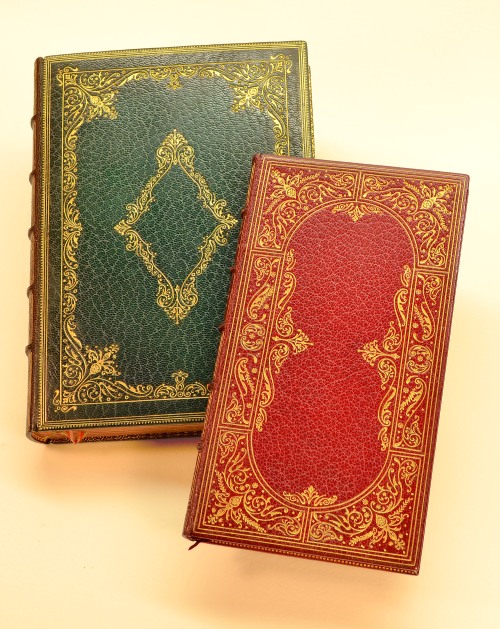
“English Verse” together with Lowell’s “Democracy”, both small Private Press 8vos, and sharing about 8 to 10 Tools in common between them
About 8 years ago I stumbled on a volume for sale on eBay. I missed this one, losing to a bid of a only few dollars more. I was new to eBay, and it cost me. It is not in my collection…. Note the tools and the style of the front board, very much in keeping with “English Verse” above, and sharing a number of the same stamps with it and the “Democracy”.
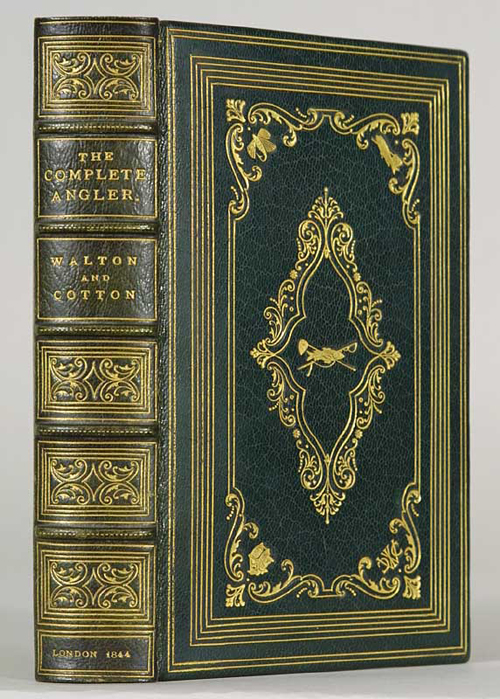
“The Compleat Angler”, Walton and Cotton; in a Stikeman binding executed ca. 1892, front board exhibiting the same stamps as a number of bindings from this narrow period in the firm’s output
The text of “English Verse, Chiefly Lyrical” is a collection of “the Best of English Lyrical Verse”, with “Ballads and Romances excluded”, compiled by Louis Henry Bristol, an “expert in Fine Bindings” and “Member of the Grolier Club since 1890” according to his obituary. He studied English and Law at Yale, and joining his father, became a prominent Lawyer in the New Haven area. A noted book collector, he gifted Yale with an incunabula collection in 1909.
The volume was executed on what was at the time called “Japanese Vellum”, in only 15 copies, for private distribution by the author.
It’s not clear if this binding represents the manner in which all 15 were bound. If so, it would have been a very expensive proposition.
This copy was, by all apparent accounts, owned by James TenBroeck Hillhouse, and bears a pen inscription ” J.T.H. from L.H.B”. The front inner board bears an engraved bookplate executed by the famed New Haven artist and engraver William Fowler Hopson.
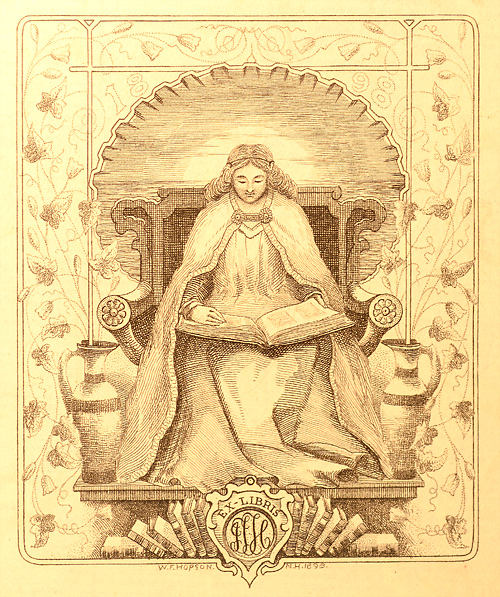
Engraved Bookplate by William Fowler Hopson, New Haven, 1898, with the Monogram “J T H”, erroneously listed in the Hopson Catalogue Raisonne’ as “J H H “
This bookplate is a known work of Hopson’s but, given the exuberance in the monogram, is everywhere catalogued as reading “J H H” rather than the “J T H” visible on closer inspection, and which concurs with the author’s inscription. James TenBroeck Hillhouse was a Yale man as well, won the same prize for English Essay that Bristol had, both were members of Phi Beta Kappa, and both were from very old, very prominent Connecticut families.
The binding has a wonderful scale difficult to appreciate from photographs, and which was certainly not evident in the seller’s photograph; a straight-on flatbed scan devoid of subtlety. The fineness and delicacy of the tiny tools is indicative of Stikeman’s earlier, especially pre-1900, work.
Here it is again, with bindings from the shop which date from the same period (and earlier described above). The effect of the hundreds of tool marks, coalescing from single tool marks into a broad textural pattern across the boards and filling the spine compartments, is fairly phenomenal when viewed in “real life” as opposed to a photo. The highlights rising and falling, almost literally ‘twinkling’ (to use a term offered up by exhibition correspondents a hundred years ago). The effect is hundreds of small sparkling gold bright points, as the book is viewed from a number of angles or turned from side to side in the light.
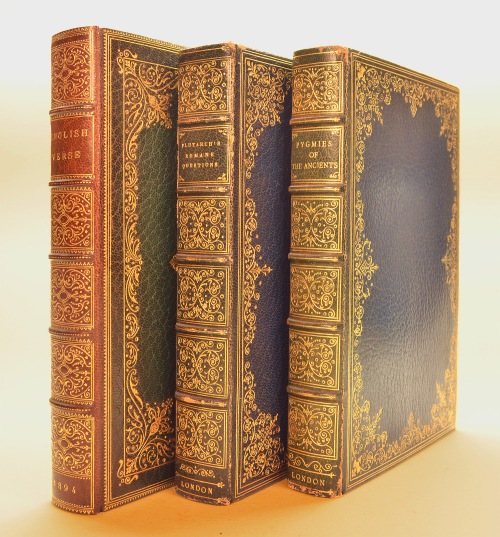
“English Verse” together with “Plutarch’s Lives” and “Pygmies of the Ancients”, all ca. 1892-1894; the three volumes share a good number of the same tools which were used to produce the design
-Update-
December 2013:: ” Elizabethan Songs”
An Inventive Asymmetrical Binding, ca. 1893
I have been watching this volume for a couple years. There are a small number of bindings in various book dealer’s inventories which I roll around in the back of my mind, debating whether to add them to the collection. Few of them have been as curious to me as this one.
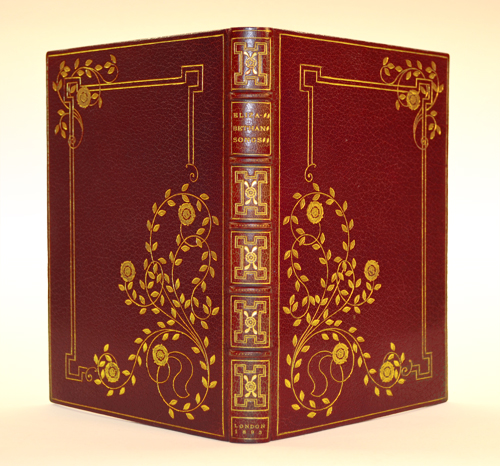
“Elizabethan Songs”; by Edmund H. Garrett; Full Title: ‘Elizabethan Songs in Honour of Love and Beautie’ Collected and illustrated by Edmund H. Garrett with an introduction by Andrew Lang. London: James R. Osgood, 1893.
What’s interesting to me about this binding, and it’s important to note that it was executed by Henry himself only about five or six years into the firm’s 45 year history, is that it does not quite follow the standard approach of the period for bilaterally symmetrical design of the boards. Typically, almost universally in fact, the English and New York binders (and the vast majority of the French) tended to design a binding whose individual covers were identical in design, with each board itself being symmetrical in pattern from side to side, and top to bottom. There was an axis of symmetry horizontally in the middle of the board, and vertically down the center, with the design mirrored in each direction.
This Binding is different. The boards mirror about the spine only, and each board is decidedly asymmetrical. Only when the book is fully open is the entire design visible. It’s highly unusual for a New York binding of the period, and for Stikeman.
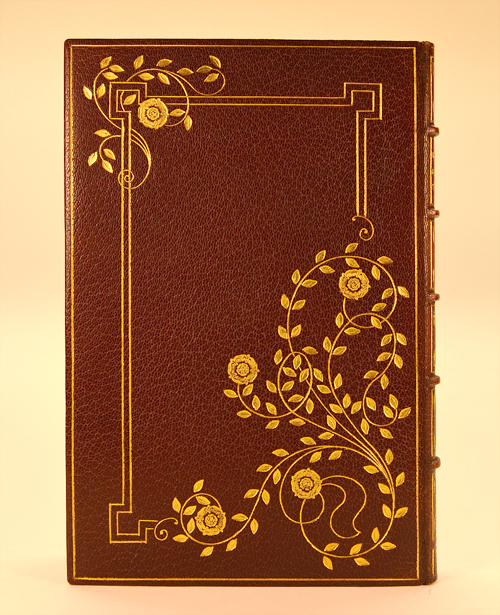
Rear Board of “Elizabethan Songs”, Showing an Asymmetrical Design of Hand-Tooled Twining Stems, with Tudor Roses, Curlicues, and Greek Key Corners
The volume is about 7 inches tall, and the scale somewhat different than in the photos, where we almost always imagine the binding to be larger than it really is. This means, generally, that the tooling reads more delicate and fine in the hand than in the somewhat clinical photographs of a catalog, or web page, for that matter. Both boards, being mirror opposites, are obviously hand-tooled, with the minor differences indicating the human hand rather than the brief brutal impress of a block stamp, an inelegant economizing machine prevalent and used in all binderies at the time (including on occasion, Stikeman and Company).
The issue of symmetry has occasionally been implied to be somewhat of a shortcoming, as though it were a crutch. If so, it was a crutch used by just about every binder who had ever took up a brass stamp. I remember though the specific assessment of a rare book and binding expert, binder, highly respected instructor, and historian whose take on Stikeman’s work, though highly positive in toto, offered clinically too that it (to paraphrase) “exhibited conventional bilateral symmetry”. Oh dear.
In truth, I’ve seen literally thousands of volumes executed by the bindery, spanning their 40-45 year period of production, and the assessment is a little premature, or at least limited in scope. In the earliest years, experimentation was the order of the day, not the exception. There are bindings which I have encountered in my deep scouring of available auction records and trade literature of the period, and if anything, asymmetry and non-standard design seemed to be the thing the bindery was known for.
Because they are ‘lost’, and because I am looking for them (and competing with dealers to acquire them), I have to speak in generalities. But there are perhaps fifty decidedly unconventional bindings which I know of off hand, done in an experimental manner that upends the ‘typical’ expectation of an American binding executed ca 1885-1910. I’m glad at the moment to have this one.
-Update-
October 2014:: “The Passionate Pilgrim”
A Finely-Tooled Binding, ca. 1896
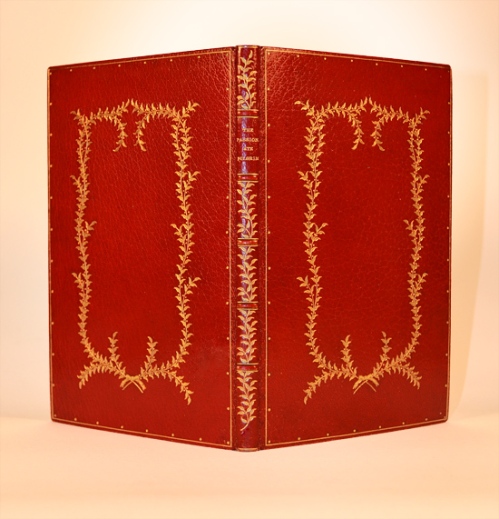
The Vale Press “Passionate Pilgrim”, 1896, with Woodcut Border, Vignette, and Initials by Charles Ricketts; in a Contemporary, Fine, Hand-tooled Binding by Henry Stikeman
I had been aware of this binding for some time. It was sold at auction in 2002, and quickly vanished. A number of years ago though, it reappeared in the catalogue of a highly regarded dealer specializing in rare bindings. The photos were small, and its unusual quality wasn’t readily apparent. So I let it percolate in the back of my mind for the better part of a decade, as I sought out other examples which could be had more readily, or without the premium that going through a dealer typically requires. It’s on a Vale Press imprint, with a woodcut by Charles Ricketts, and some of the premium was tied to the content as well (understandable).
But I collect bindings, often over content. And this was an unusual one. The tooling is deceptively reserved, the design seemingly simple and not overly bravura. Overall the scale is quite small and fine, diminutive, delicate even. The majority of the tools (comprising left-and-right-facing leaves, curved gouges, flower tools, and dots) are miniscule, and built up impossibly close to each to form the curving vines.
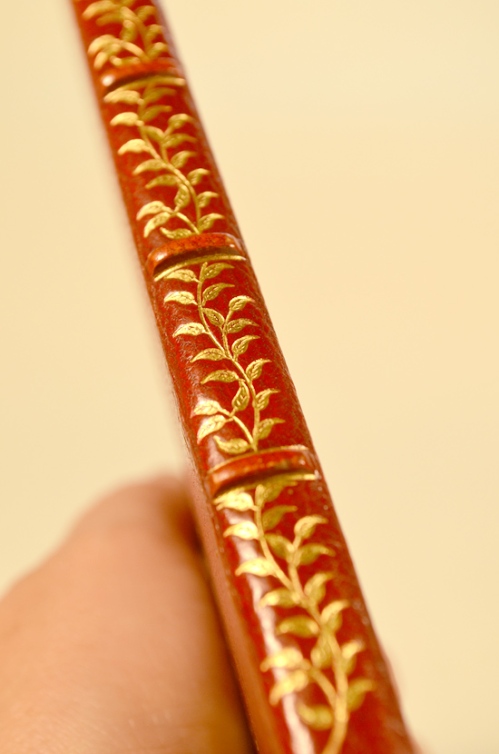
A Detail of the Spine of “The Passionate Pilgrim”, showing the curving tendril or vine which rides the spine in a sinuous curve, interrupted by the spine hubs. The curves here made of gouge tools, and the leaves tooled separately.
Altogether, the effect is pretty astounding though. Like simply strung pearls, the individual leaf and tiny dot tools are linked together to become the twining vines. It creates an effect more striking than the sum of its simpler parts. It’s like a thousand whispers becoming a loud clear high note. Each front board exhibits approximately four hundred separate gilt tool impressions, but the entire design not more than five inches high, and the vines less than a half inch wide.
Now, counting tool impressions is not simply a numbers game, as though a book is better for having more. It’s merely an attempt to emphasize what skill and effort is required to tool what appears to be a deceptively simple design. There is after all only one ‘element’ on each board here. It’ just that each required 400 impressions, and each impression at least a few repeated efforts to be completed.
The binder William Matthews trained Henry in tooling (more properly “finishing”). And so witness here Matthews’ comments on tooling specifically, from a lecture he delivered to the collectors of the Grolier Club, a few years after Henry took over the operation of the Matthews’ Bindery:
For the last year or so, this binding has been one of a very few volumes offered anywhere in a binding executed by Henry himself, and I finally decided to enquire about it. but the dealer and I weren’t able to come to terms on it, unfortunately, and I was resigned to let it ride on the open market a bit longer. We can’t have everything.
At the beginning of October, I heard that it was to be offered in a new catalogue mailing. With regard to seeing it again, let alone owning it, that would likely be the kiss of death. Someone else would likely acquire it. I enquired a last time, but it did not come together. Still, there are always others out there. We just need to practice patience.
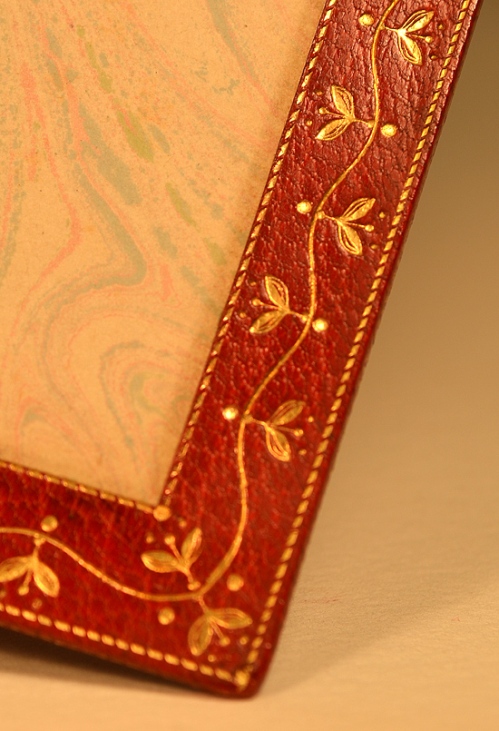
Detail of the Rear-Board’s Turn-in. It’s important to note that all the gilt decoration was tooled separately, and not with a rolling repeating tool, as is typical. The curving centerline ‘vine’ here is made from a single small semi-circle gouge tool only a quarter inch wide, applied end-to-end in alternating fashion. The dots and flower tools also separate.
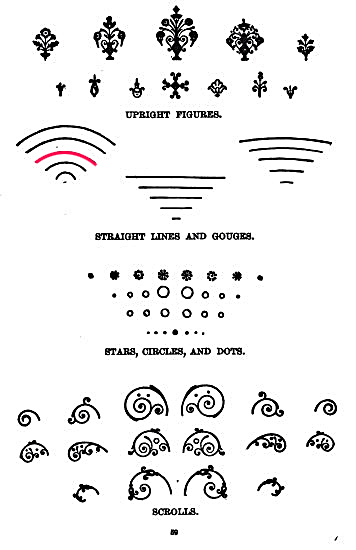
Highlighted in Red at upper left is the type of curved Gouge Tool used in tooling the curving tendrils on the spine and turn-ins. (from “Modern Bookbinding, Practically Considered”, by Wm. Matthews)
I connected with David Brass (see the “Elizabethan Songs…” binding, above) around the same time and we were talking about ‘Stikeman’ bindings in general, and what examples there were which were known and available. The “Pilgrim” came up of course, and I mentioned my lack of success in acquiring it. We agreed that collecting is a waiting game, and one unfortunately often lost.
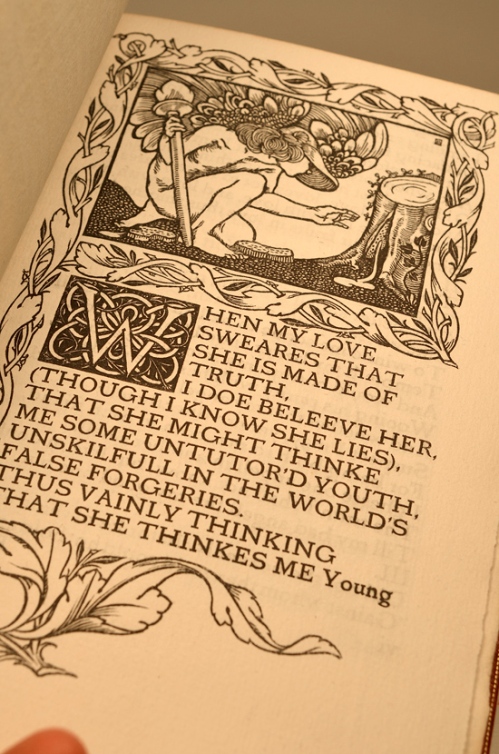
Woodcut Vignette of the “Passionate Pilgrim”, with additional Woodcut Borders and Initials, designed and carved by Charles Ricketts for the Vale Press
A day or so later, a return phone call from David, and he said that, as luck would have it, he now actually had the ‘Pilgrim’ in-hand himself and wanted to know if I was interested, whether we could make something work. Um. Yes. And we did, obviously, “make something work”. It arrived by the end of the week, the deal conditional on my approval of the binding, and his acceptance of my offer for it. It was better than described, and perfect ‘in-the-hand’. And all that remained was a phone call in thanks.
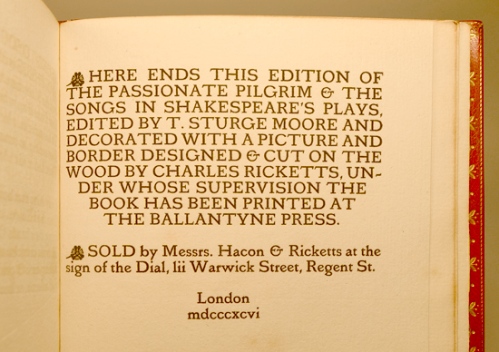
Colophon of the “Passionate Pilgrim & the Songs in Shakespeare’s Plays”, designed and printed in the first year of the Vale Press; with Presswork by the Ballantyne Press.
I’ve been studying and collecting the Stikeman Bindery’s work for perhaps 20 years, and have certainly missed many more books than I have acquired. But the history of collecting is filled with stories like these, where objects and collectors suddenly, finally, come together, whether serendipitously or by design, even after they have been given up for lost. Apparently, this time it just so happened to be my turn. With many thanks to David Brass of David Rare Books, who this year is celebrating his 50th anniversary as a Rare Book dealer.
-Update-
November 2014 :: An Examination
or
The ‘Autopsy’ of a Stikeman & Co. Binding
This month I purchased a damaged copy of a rather common title. Common, at least, for a book in only 250 copies. It’s not a highly collected title, but it was done in a very high grade binding, and so proved the perfect specimen for deconstructing and recording the process. The link here will download a fifteen (15!) page PDF of my “Autopsy Report”, for lack of a better phrase. If any comments or corrections, feel free to let me know.
::::::::::::::
A White Whale
A Grolieresque “Maioli’ Binding by Stikeman, ca. 1892
I wish I could say this one was in my collection, but it is currently “off the market”. For me, though, locating it was almost as good as acquiring it. It, and its two similar siblings (in different patterns and colors), are among my ‘white whales’, bindings I hunt like an obsessed Nantucket whaling captain, hell bent on taking down my own ship in the quest to land it. I have a number of these which haunt me, just out of reach.
It is the third variant of a Grolieresque Stikeman binding on the Grolier Club Publication “A Life of Jean Grolier”, by William Loring Andrews. I knew of two copies, one I missed out on when I was just starting to collect. I turned up this copy in an obscure mention of an old catalogue, and suspecting it was another inlaid binding, finally tracked it down to its present location. Sorry to be so obtuse, as these things are so rare, it’s best to not blather about where they are.
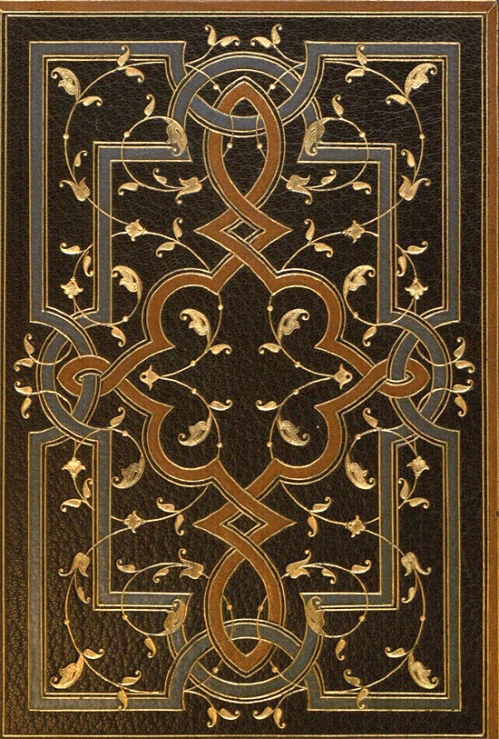
About full-size, a Grolieresque Binding by the American Binder Henry W. Stikeman, done ca. 1892, on a copy of Wm. Loring Andrews’ “Jean Grolier De Servier Viscount d’Aguisy, Some Account of His Life”, published by The Grolier Club, N.Y., 1892
Suffice to say, it is, I think, a spectacular American example of homage being paid to the fantastic bindings associated with Grolier. It is ca. 1892, and both boards are done in the same pattern. all tooling is by hand, built up of multiple individual impressions, including the offset filets and thin gilt lines which follow the onlaid strapwork. These same tools were used on the other two binding variants, in similar, but entirely different patterns.
An enlarged portion of a quarter of a board shows the minute variations in the application of the tooling by the human hand.
To reiterate… this volume is not in my collection. But all good things come to those who wait. Eventually, volumes like these re-enter the market, as indeed they are intended to, passed from one collector to another. None of us really “own” these. We merely act as stewards, and take care of them until the next poor soul who shares our disease comes along to take their turn protecting them.
© Jeff Stikeman and jeff stikeman architectural art, 2009-2010. Unauthorized use and/or duplication of this material without express and written permission from this blog’s author and/or owner is strictly prohibited. Excerpts and links may be used, provided that full and clear credit is given to Jeff Stikeman and jeff stikeman architectural art with appropriate and specific direction to the original content.

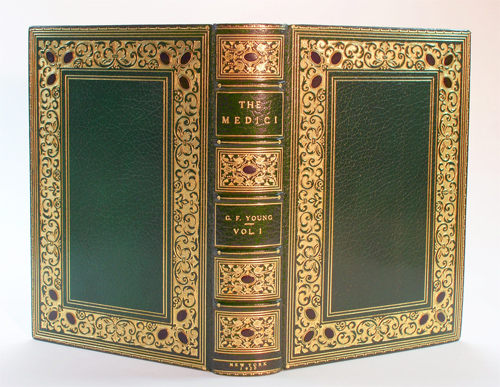
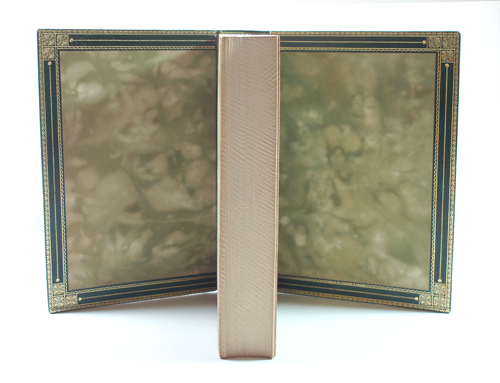
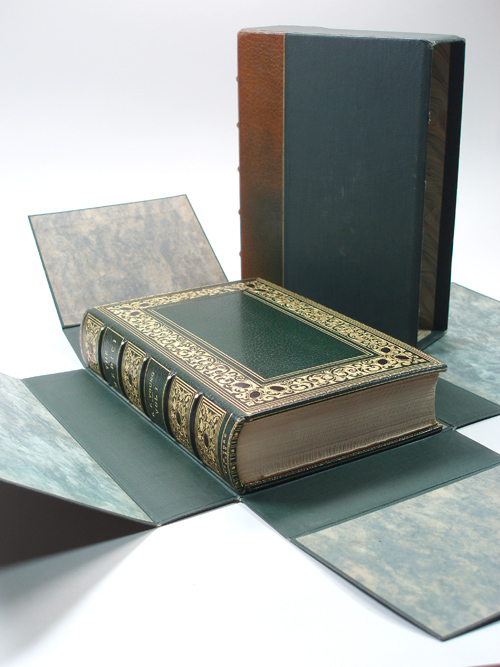
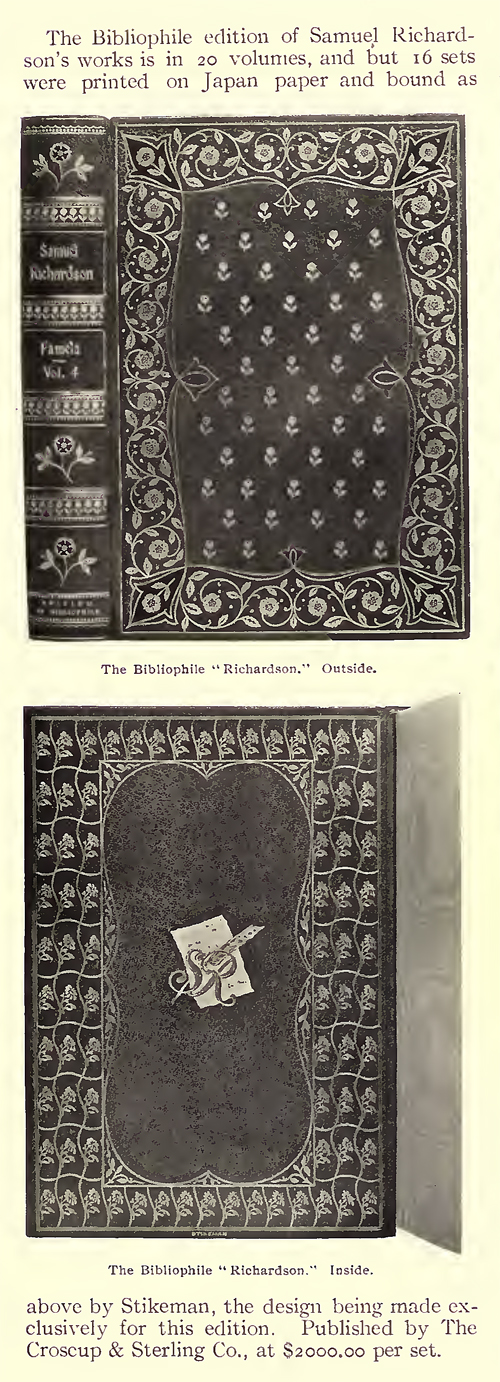
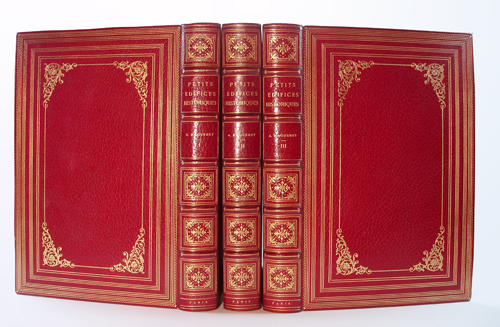
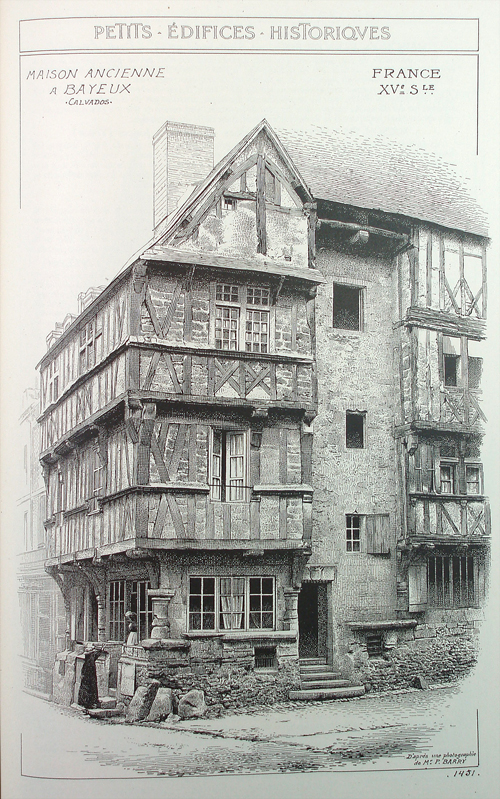
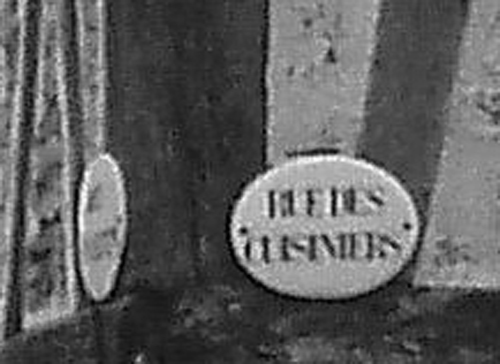

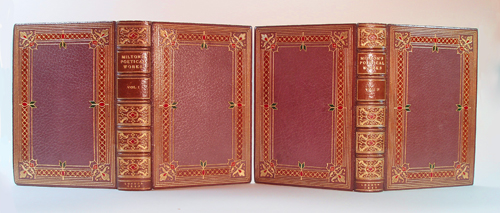

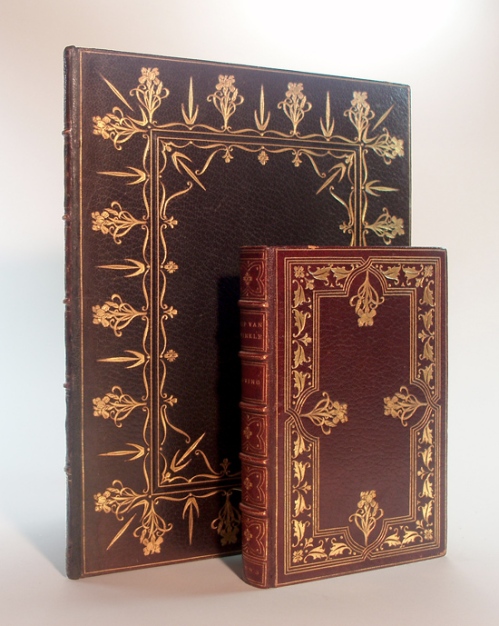
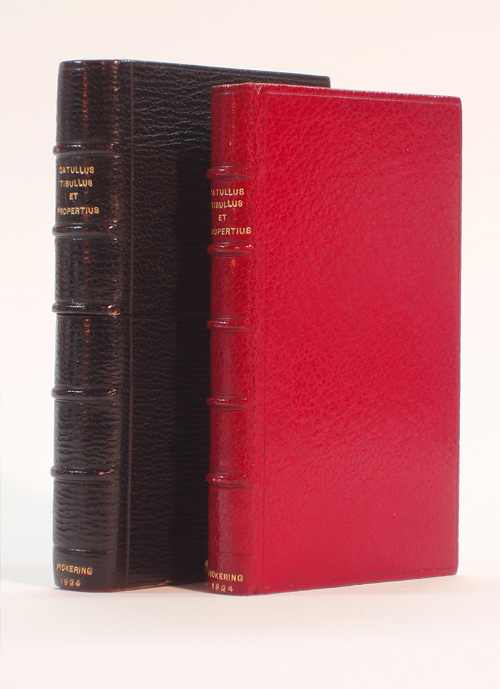
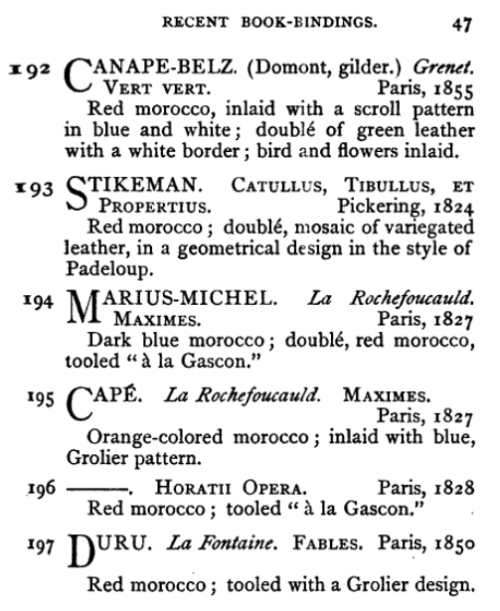
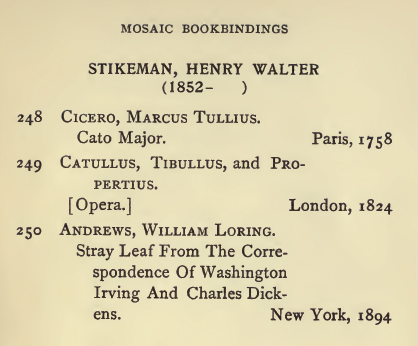
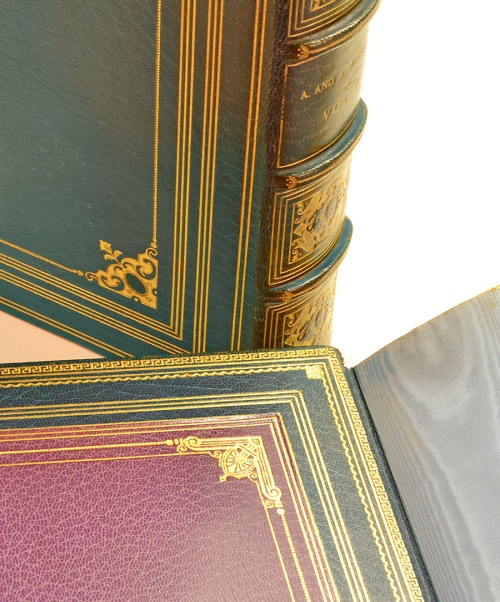

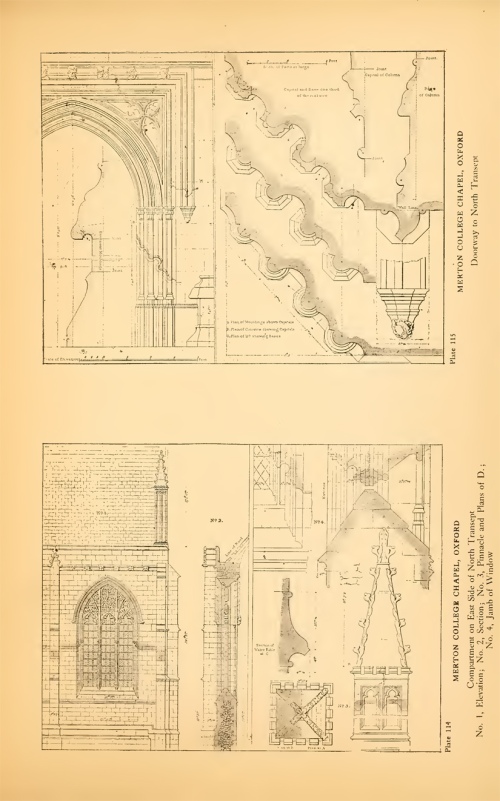

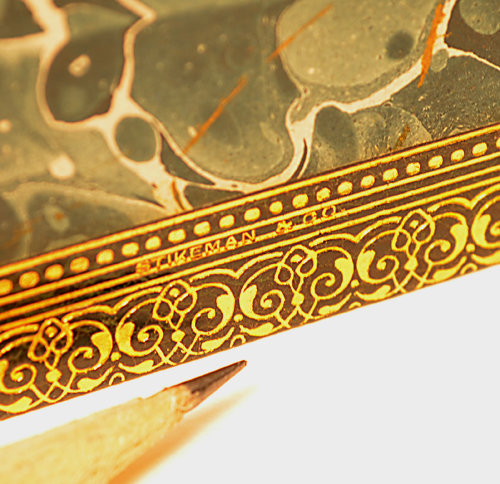
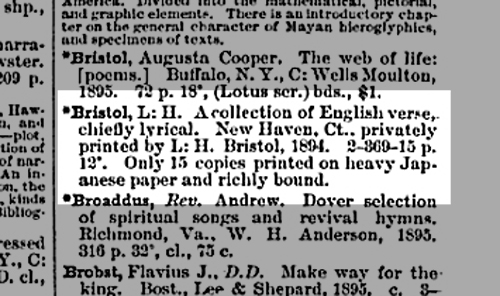
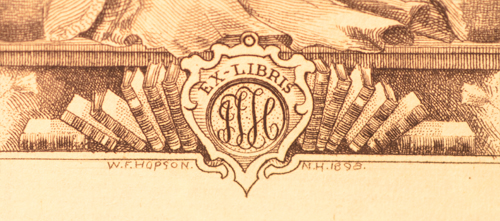
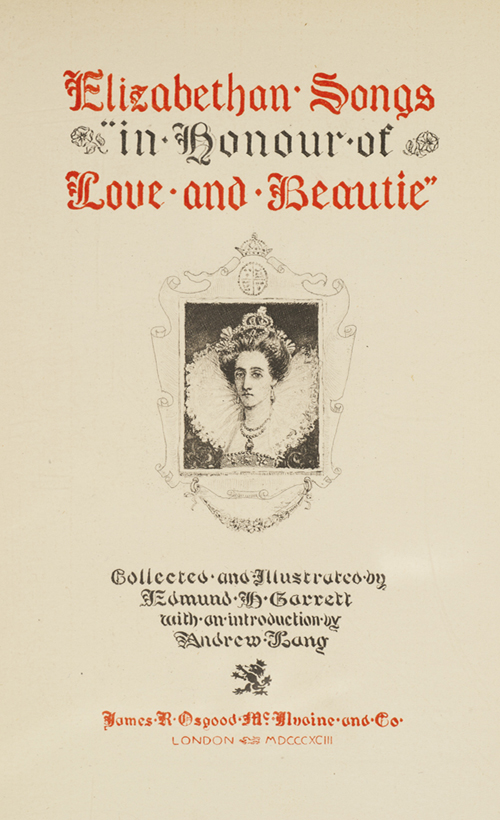
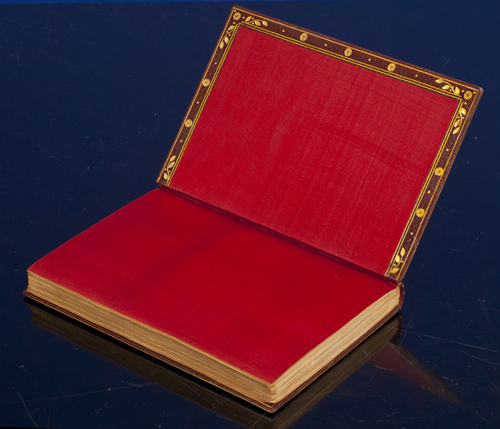
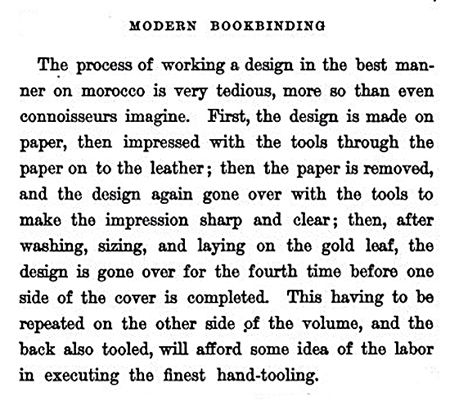

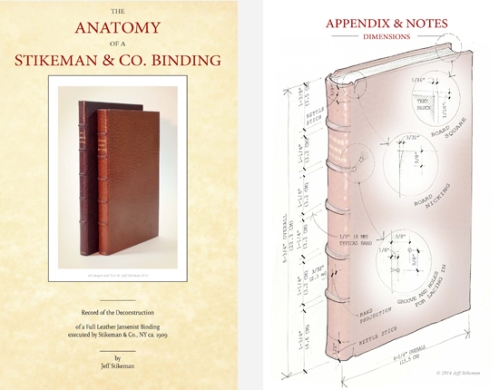
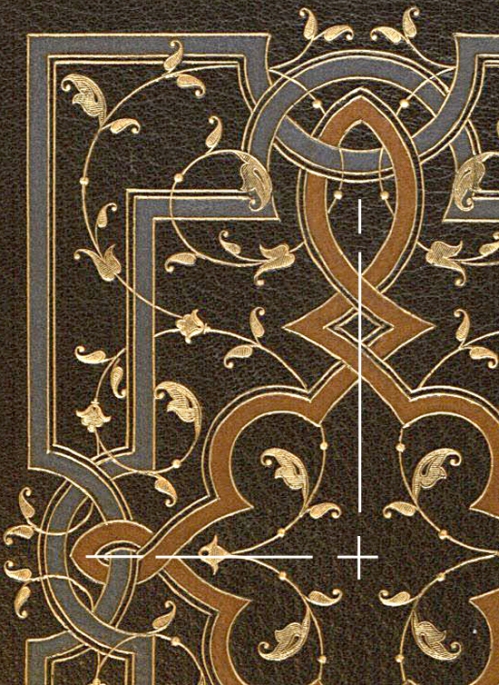
Pingback: Judging a book by its cover – Compost & Grace
Jeff, How great to have found your blog. I have an 1895 copy of the Pilgrim’s Progress published by Nimmo in a Stikeman & Co binding. I am putting it up for sale on eBay and wanted to know what kind of value it has. Thanks for the detail on the company and your connection to the binding. I have had this volume for over 20 years, but it is time to downsize my library. Thanks for the help. Vince
I have learned a lot, not only about Stikeman´s bindings but about book binding in general. I have enjoyed your style of telling a story too. Thank you!!
Pingback: Christmas Carols, New and Old… edited by Rev. Henry Ramsden Bramley (1871) - Rare Books & Special Collections
Spectacular bindings, and obviously a labor of love. I was brought to your site because I was trying to hunt down information on Stikeman bindings executed for an exceedingly scarce Charles Erskine Scott Wood title, A book of tales 1901, which was letter press set and printed by two teenagers in his attic with 105 copies, and 39 specially bound subscriber’s copies by Stikeman with North american Indian motifs and designs on covers & inner dentelles. Great information, and well done.
Hi Kol.
Sounds like an interesting little production. If you happen to have any photos, send them along and I’ll see if there’s anything I can tell you about them.
Thanks for your comments about the bindings, too. They don’t make ’em like they used to, do they?
Best,
Jeff Stikeman
Sure Jeff,
Do you have an e-mail address in which to forward photos? The binding does have some rubbing at corners, and minor sunning to spine but still, very scarce title.
Kol
Hi Kol.
email is info (at) jeffstikeman (dot) com [no spaces, no capitals]
Thanks again
Jeff
Hi Jeff,.
It was great to hear from you again up here in the mtns of NH,….where as we have some lovely snow falling as I write back to you now …I hope your holiday is going well as mine is and Merry Christmas to all…
Now lol… As far as the book cover I sent you ,I did see there cover book that was stamp out in red as well that year ..and wondered the same, but then I had a clear moment and thought they wouldn’t of poped it in the museum and said its hand tool if it wasn’t hand tooled …but lol I guess You would have to drop them a line and see who said it was and supply you with better pictures if you have any intrest to and better info other then what’s showing ,.. as for the style My first thought was Henry did his in 1892 and yes many would copy this style , but I saw the play fullness of the style of the lines and said just maybe ,,,smiling.
And why didn’t Roycrofts say,.. who did the tooling on binding.. or even a guess seeing they put it in there museum……K sara sara …lol
Thank you for take the time to convers about my whim’s …I understand why you have a great blog…Forgive my typo’s… lol
Gary
Hi Jeff,
this book reminds me of maioli binding by Stikeman in 1892..Roycroft does’nt say who did the tool work or binding on this book as far as I know todate ..
http://www.roycroftbooks.org/american_bible_1918_hubbard_museum.htm
Hi Gary.
I just saw this comment (I was off line over the holiday). Thanks for sending the link.
The Maoli bindings all shared very similar tools (the buds and leaflets, for example) across almost all binders working in this style, because they were ‘borrowing’ the design from earlier precedents. I know that Henry later used the same set of tools on ‘Stikeman’ work which were used at Matthews’ bindery when they rebound the Huntington Gutenberg in a Maoli binding. There’s an excellent similar set discussed here http://www.cyclopaedia.org/16c/picquestools.html (this is a fantastic website, btw).
The Maoli style was pretty well entrenched, and I think every binder seemed to have done a few in it. I don’t see any tooling here that implies it could be Stike&Co. The article mentions four variants of bindings on that text. Are there other examples in the same Maoli style?
Do you happen to know if that binding is block-stamped, rather than hand-tooled? If this design was a variant among four, and produced in any great number, I’d think block-stamping was the way it was done. This is a good bit easier than hand-tooling, and was a standard method for producing consistent gilt bindings across a large number.
In the examples I have handled, the designs used to make the block stamp (the actual physical stamp or die) were made from a pattern which had in fact been built up or tooled by hand. So we still see the same evidence of the human hand. It’s just that in every following binding decorated by the block stamp, these ‘tells’ or human hand indications appear in the exact same place every time. Whereas in a set of bindings done completely by hand, the designs may appear similar, but show tiny variations from one to the next.
Please keep in touch. I haven’t (until seeing the ‘Village’ example) encountered any Stikeman binding on Roycroft works. But thee should be more, given their overlap.
Best, Jeff Stikeman
Hi Jeff,
It was great to hear back from you so soon … As well as talking to you… I been emailing R Blancherd who is one of the biggest collector of Roycroft books, Which a lot of them you can see on Paul Jackson’s website .. Roycroftbooks.org…which will show most of the top end collectors of Roycroft books….the pictures of the book we are talking about are rather weak ..lol.. So I cant really pick up on the damage on the spine and they sure don’t speak of it in there listing ..smiling.
your summary of the book makes sence…as it being a rebind by.. Henry..?
Thank very much for time and help …and I’m sure the boys from Roycrofts and myself are looking forward to hear more from you in the future.as to any insight you may have on Roycrofts
.
Gary
Thanks Gary.
I think we were able to zoom in on the binding photos a bit more, but for me I decided that notwithstanding the sunning and (what appeared to be minor) hinge cracking, the binding was not really of the type which I am collecting at the moment. It seems a pretty typical full-leather binding for that period though. …in keeping with their high grade output. It just didn’t ‘fit’ my collection at the moment.
I will certainly share anything new ionformation I encounter on this one (or another Stikeman on a Roycroft) with you.
Thanks for your interest in the bindery. Jeff Stikeman
Great job ..,I collect Roycroft books and am a great fan of Louis kinder …and I just saw a book binding on a Roycroft book ,… tooled by stikemam..which at first glance I thought was Kinder …smiling…. Do you know if this was a wim or did Elbert Hubbard pay him to do this and other covers … thank you.. Gary
Hi Gary.
Thanks for your kind words and question.
I was turned onto the Roycroft website (roycrofter.com) by a fellow collector. We’d been discussing how we started collecting, and I mentioned that among my first collected books were a few Roycrofts (I still have an as-new ‘Essays of Elia’, in-box, with the edges of the limp suede still bright and square-cut). We, the other collector and I, also shared an appreciation specifically for Kinder’s work. In fact, I had earlier mentioned to him my love of Otto Zahn’s work, and he clarified that the Zahn finishing work which I appreciated most was actually Kinder’s. It is like a meeting of the Mutual Appreciation Society.
A couple weeks ago, we were discussing the very binding I think you are referencing (“The Deserted Village”), a Stikeman on an illuminated Roycroft. Both of us were interested but for the damage to the spine, which was regrettable. Our consideration revolved primarily around the design and tooling.
He too asked what I thought about the relationship between Stikeman and Roycroft, whether there was anything to it. My conclusion (and it’s speculative, admittedly) was that I do not believe there was a commercial relationship, where Stikeman & Co. were doing art-binding for the Roycrofters, even on a limited basis. Whenever Stikeman and Co. did a binding for a publisher (using Scribner as an example), or even a bookseller (Brentano’s), they seem to have noted as much in their ink-stamped signature. e.g. “Bound by Stikeman & Co. for Charles Scribner’s Sons”.
My present thinking is that”The Deserted Village” was a rebinding, done as a one-off. It appears to me (in terms of tooling) to be later than contemporary to the 1898 date.
All of this is based solely on experience, and is potentially undercut by the limited sample size.
If you know of other Stikeman bindings on Roycroft work, I would be happy to check them out and tell you whatever I might that could be of interest. And if my reply prompts and further questions, don’t hesitate.
Thanks again. Jeff Stikeman
Hello – I am a pastor and collector of theological works. I have run across a set of books on the Life and Letters of Phillips Brooks with apparent Stikeman bindings. Was “Stikeman” typically marked on books of this era – 1901?
Hi Phil.
Yes, you can expect to find “Stikeman”, “Stikeman & Co.”, or “Stikeman & Co., NY” stamped on bindings from around this period. They operated from 1887-1932
Best,
Jeff
Don,
Are the titles on the spine those of individual short stories, or of novels? And are the few pages missing just one or two, or a block of an eight inch or so? One way manuscripts were kept a century ago was to mount them on the pages of an album. A few pages would be stubbed out to make room for the thickness of the insertions. When, at a later date, the manuscripts are removed from the volume (to save space or for better conservation) the safe and easy way to do it is to cut out the carrier pages with the manuscript still attached.
I haven’t come across individual stories mounted in one thick volume each with a lot of blank paper, but it would make sense in the context of older collecting, making a bigger, better display of objects that are likely to be a bit drab on their own. However, sometimes the flexing of the carrier page causes breaks in the manuscript page; and shelf space is much more an issue today than it used to be; so today manuscripts are often removed from bound volumes and stored in boxes.
…As Jeff says, if you trace the history of the manuscripts in the titles you may be able to get more information. With my own background I might start at the other end: a recent scholarly edition should give the location of manuscripts if known; or it they have come to rest in an institution, then googling the title and “Manuscript” may bring up the current location.
Hi Jeff,
I have enjoyed reading through your blog and find myself shaking my head at the grandeur of the workmanship. There is nothing like a well executed doublure, and some that you illustrate are breathtaking. I have had the unexpected pleasure of stumbling across a set of Stikeman bound “books” at an auction that lend credence to the expression “you can’t judge a book by it’s cover”, and wonder if you might take a stab at guessing their purpose. 15 volumes, roughly 9 x 12, full leather, raised bands, gold tooled covers, spines, dentelles, aeg, moire endpapers and paste downs. About half of them are stamped on the endpaper “Bound by Stikeman and Co.” All are titled on the spine “R.L. Stevenson Unpublished Manuscripts”, and each with a subtitle of the specific work. But when you open any one one of the books they are filled with blank pages. I would be glad to send some pics if you would like. I wonder if they were a custom order to be used as a journal or diary, since in some of the volumes, the first few pages have been cut out. Altogether they make for a lovely appearance on a book shelf! They are nicely done, but not with the intricate details of many of the works you show. Thanks again for hosting such a fine tribute to one of bookbindings best,
Don Menzies, Woodbridge, CT
Hi Don, and thanks for your comment.
What you describe sounds like a dummy set, bound as a trial or display model prior to the text itself being published. I find no record of the specific Title (“R.L. Stevenson Unpublished Manuscripts”) ever being produced, although there is a similar title that was printed privately. This is complete conjecture on my part, but here’s what I imagine the case may be: At the outset of the first World War, a collector of Stevenson’s work, Mr. Francis S. Peabody, purchased a large number of Stevenson’s previously unprinted manuscripts spanning a number of New York sales during 1914-1915. It was his stated intent to publish them in their entirety. It follows that he may have sought to pre-sell deluxe volumes and perhaps other limited sets (in 3/4 leather also, for example) in order to generate the funds required to do so. Buyers would likely have been shown a prospectus describing the titles, the limitations (how many deluxe sets would be published), and the cost. A fully-bound set (but blank, because the text had not yet been printed) would likely have been produced in order to provide a photograph of the intended production. After preselling enough subscriptions (commitments) to purchase, the publisher would then be able to go ahead and actually have the text type set and produced.
Apparently, not enough interest was shown, and the larger project failed, and the full set never produced. It was early in the most devastating period of war in human history, and attention (and cash) was perhaps focused elsewhere. Additionally, it seems even more Stevenson material turned up, which may have delayed production, or cause the publisher to consider a different avenue. For example, a smaller set of manuscript “Prose Works” were issued in 1921, by the Bibliophile Society. This may have been the first of an anticipated much larger series of published collections, whose scope was far beyond prose works. According to a preface to this edition “He wrote poetry, novels, short stories, technical and ethical essays, dramas, fables, prayers, sermons, tales of adventure, literary criticism, history and biography; and he was withal one of the most entertaining and self-revealing letter-writers of the nineteenth century.”
I haven’t had the time to tie up any loose ends and solve this definitively, but my advice would be to record each title, and then check those titles against auction records. You will readily find reference them online I’m sure, in either google-books-scanned auction catalogues, or perhaps even the press of the day. If you can tie those titles to the New York sales in 1914-1915, and perhaps Francis S. Peabody by extension, then you’d have a solid bit of evidence linking this set to his intended publishing of the previously “unpublished works”.
If you’d like, I could review some photographs for you of the bindings and let you know whether there’s anything to be gleaned from them.
I can tell you that the set would NOT have been produced in its entirety merely in order for the binder to show the publisher a design concept. The design would have been done on paper, using ink instead of gilt, and using the proposed stamps. If any fully-bound test pieces was to be done, only one of them would have sufficed. Therefore, I’m pretty certain the set was executed fully so that it could serve as a display piece and/or be photographed for the purpose of advertising the entire production.
Curiously, the size is folio, and that implies (to me) that perhaps in fact the text would not have been typeset from the manuscripts, but instead actual photographic facsimile reproductions of the manuscripts themselves (at full-size, on letter-sized paper) might have been intended. …because if type-set, the size would have certainly been smaller.
As to the missing pages at the front of a few volumes? I’m assuming that ALL pages were blank, and that there aren’t even any half-titles or title pages. Nothing but totally blank leaves. And so, sure, it seems someone may have used the set over the years as a journal or scrap book (no sense wasting that paper and binding, I suppose), and then when the time came to dispose of the set, the few used pages were excised to remain with the prior owner.
Please send some pics if you can, and I’ll take a look.
Apologies for the delay in the reply.
Jeff Stikeman
Hi Jeff,
Thanks for such an amazing blog about Stikeman & Co. I recently bought 3 first edition books that were published in London, England in 1825. They are by my ancestor (Richard Ryan, biographer) and called Dramatic Table Talk. The family had not passed down any of his books so it was very exciting. When I received them I couldn’t believe the binding – it looks band new. A friend even said that it couldn’t be original as it was in such good condition and that it must have recently been rebound. However, on the inside front, after the inside cover design there are the words “Stikeman & Co” in very small writing and I decided to Google them and thus found your blog. Am I to assume they were recovered more than 100 years ago by Stikeman in the US after someone brought the original books Over to the US?
Best wishes
Paul Ryan
P.S. I have bought some other first editions by Richard Ryan from 1821 and they have been rebound in a very plain way. I have been told that it is possible to get them rebound in the original way and I was wondering if you recommend that and who does it now?
Hi Paul.
I’ll send you a private email so that I can talk to you more about the bindings. I would really need to see them in order to be able to tell you anything about the period they might have been bound, which could be any time between 1890 through 1930 or so. …but yes, they would have been bound here, in New York, after having been published in London and carried here by a previous owner.
Look for a follow up email in a bit.
Best,
Jeff Stikeman
Pingback: BAYEUX, YESTERDAY AND TODAY | R O C K R O S E W I N E
My gut feeling about Kalaba is that he “tricked out” his resume as well. It reads just a bit too good to be true. No actual lies that I know of…. just tarted up a bit more than it should be. But I suppose I’m being unfair…
“Bookbinding and Book Production” Magazine mentioned “Mr. Kalaba’s proficiency at fore-edge painting, which he has taught others;” unfortunately it gives no further details. My copy is an undated clipping, but the article, titled “Craftsman,” appeared on page 40 of an issue that seems to have been in the spring of 1937.
Tom Conroy
That’s interesting, thank you Tom. Based on the quality of the fore-edge paintings I have by Kalaba, I’m not sure I’d go so far as to say he was ‘proficient’. They seem a little weak, but I have not seen very many.
Most everything I have relating to Morris Kalaba seems to indicate that he tended toward tricking out books whenever possible, up-selling. Like a car salesman pushing for undercoating. Especially after Henry retired.
I greatly appreciate your adding to the conversation. The information you provided earlier was fantastic, and this extra nugget adds to the overall picture of the firm I’m putting together.
Thanks again.
Jeff
Jeff,
I obtained today a two volume “Life of Cellini” published by Brentanos, New York in 1906. The back doublure has the stamp “Bound by Stikeman & Co. N.Y.”
I found your glowing site which immediately offered me considerable satisfaction for learning about the binder of this Cellini set. These books I have are bound in full red leather with cover panels that offer wide borders. These are made up of lunettes filled in with floral devices. I looked closely to see if the designs are built up from small tools. What you offer here by way of instruction in your own descriptions, has me thinking they are indeed built up, and not large single stamps.
I welcome reading more carefully all you offer here—with your gorgeous photographs—as I study these Cellini books with greater interest. I’ll be keen to train my eye to detect the “scintillating” quality of gold on leather, that your own shining prose so happily models.
I find myself reflecting, so to speak, that I have had some good fortune today in connecting with your glowing site, with Stikeman’s gold tooling and with Cellini’s life story—he was a goldsmith after all!
Yours,
Jack Cooney
Thanks for the literally glowing comments, Jack.
Been very busy here, sorry to let things slide in reply. I’ve seen the Cellini set, but there are variations. If you want, shoot me an email with some photos, and I’ll comment on them if it will help sketch out some more info on them for you. It helps me (in catching variations), and maybe it can help you, although it sounds like you appreciate them very much already.
All the best, Jeff Stikeman
Dear Sir,
you can see http://octave-uzanne-bibliophile.blogspot.com/
Bests,
Bertrand
Hello Jeff,
This was a very interesting site to read (or just to look at) and I commend the amount of photo work and research you have done! I am a collector as well, not so much of bindings, but have come across vol. 4 (Spain) of the Gautier 24-vol. set issued by Sproul (Cambridge Univ. Press) and bound by Stikeman in 1901, limited to 180 sets using Japanese vellum (this vol. is maroon with doublures and Moire silk (dark blue) endpapers with 4 black and white gravures and one color gravure opposite the title page (duplicating the initial b&w illus). Do you have any idea about its value or scarcity? I found a similar set bound by Trautz-Bauzonnet for sale in London at $7700 but assume the Stikeman set would be more valuable. I would be happy to sell it to someone missing this particular volume (VG+ at least), or to yourself for your collection if you are interested. Thank you for any information you can provide (or your subscribers). Scott C. Walker in Fort Worth, Texas
Hi Scott.
Tough to say what it might be worth, or how rare it is, especially without seeing it. My valuation is decidedly skewed, too. I will say that as a collector of bindings, a single volume from a set isn’t as desirable as a full set, obviously. But to those who collect the subject, a fine binding can generally add a premium to the price. That said, being a ‘Stikeman’ binding vs. another isn’t likely to make it more desirable to many other collectors necessarily, as compared to Trautz-Bauzonnet. Theirs is a prominent name too. And frankly, I’m about the only person running around now specifically looking for ‘Stikeman’ vs. another binder.
I’d be happy to take a look at it for you if you’d like. Sometimes there are some subtleties to the binding that can be informative. you can contact me via email at “info @” plus my first and last name, plus dot com (no spaces). Sorry for the subterfuge. I’ve been fairly successful avoiding spam so far, though.
Hello cousin Jeff! Lovely site you have here, but I must say that I, too, am looking exclusively for Stikeman bindings. For reader purposes, Henry Stikeman was my great-grandfather. Thank you so much for all your hard work making this information available to so many! My mother will really enjoy hearing about her grandfather on my next visit. Hello from Charlottesville, VA Laurie Stephens Partner
Thank you for your detailed history and images of works by the Stikeman & co bindery. I am currently working with a magnificent (mind boggling) piece by them, Poems. By Thomas Carevv Esquire. One of the gentlemen of the Privie-Chamber, and Sewer in Ordinary to His Majesty, 1640. bound in taupe goatskin with the most perfect pointille tooling. it is as perfect a binding as i have ever seen.. If you can send me an email address i will send pictures for your collection.
J Franklin Mowery
Rare Binding Specialist
Folger Shakespeare Library
Washingtion DC
Jeff,
Your site is wonderful! As a book dealer, I am quite impressed with your collection. I recently purchased a set of the Definitive Twain works bound by Stikeman in the mid 20’s. The good thing about the set is that the condition is superb. The bad news is that Vol. 1, the posthumously signed volume, is missing. ;>( A couple of questions.
Since I have seen 1 or 2 other of these sets bound in identical full brown morocco by Stikeman, I assume this is a publisher’s delux binding. Do you happen to know anything about Stikeman’s work on this set?
I know it is a longshot, but do you know someone who has a stikeman bound vol 1 for sale? Expecting such is impossible to find, I am planning to buy a clothbound vol. 1 & have it rebound to match the rest of the set. Since the edition was 1024, this is not difficult to find. Can you recommend a binder who would be best at replicating the bindings used on the set? (Perhaps the binder who bought the stamps & tools when stikeman closed would be the best option.)
Thanks a lot for your time & assistance.
Ric Gardner
Hi Ric.
Sorry for the delay in getting back to you. I’ll send you a PM also, so we can talk a little more if you’d like, but I will offer some quick thoughts here, too.
The 1922 Gabriel Wells “Definitive” set of “The Writings of Mark Twain” was bound by Stikeman in at least two versions: a three-quarter brown morocco, and the full-leather set which you have. Wells purchased the rights to the edition and the Twain/Clemens signed sheets (he signed them in 1906) from Albert Bigelow Paine. Your set would be the Deluxe Binding variant. I have a record from the 1927 Charles Bailey auction, and it lists the 3/4 variant. I think it will be difficult for you to find a single volume (No.1) to complete your set, in any binding, without buying a full set. There are many buckram bound copies of the set available (not by Stikeman & Co.), and from what I can gather, they are all in the same size, same edition of 1024. Often, different sizes or papers (or both) were printed, and the deluxe sets were additionally ‘extra-illustrated’. I don’t think that’s the case here, and that you’ll only find binding variants on the same printing. As for copying the binding, that will also be difficult. The company’s tools are at the moment lost to history (though I am trying to track them down). Rumor has had them at the NY Public Library, in perhaps their Rare Books Conservation Lab. A true ‘copy’ (identical corner devices, etc.) would therefore require remaking the tools, which would be an inordinate expense for a single volume. Probably better to make a close copy. The leather too might be difficult. Some conservationists or restorers have small collections of vintage leather. I doubt you will find a match in the commercially available leather, but you might get lucky. Keep me posted.
Jeff Stikeman
The ilustrations of the bindings by Stikeman are unnbelievably magnificent.
I have been attempting to impress covers and doublures with compound dies which now must be the most infantile examples in book art.
I don’t know whether to give up or use Stikemans as models for any future attempts.
I once had the unique privilege of being at arm’s length of a Leonardo red chalk drawing – these covers give me the same tingle factor.
Thanks for the kind words, Karl. Some of these examples are built of compound dies or one large die, and I can say that even though on the face of it they look hand done, the way they reflect light is entirely different, and a little lackluster (literally). The reflection from a very large die is very flat, in all one plane. Individual stamps vary minutely, the handle of the tool held at slightly different angles, which means the gold’s reflection changes as the book moves. Hard to explain… The desire to use a large stamp to impress designs much faster may be tempting, but the end result will not be as visually arresting as one built up of multiple impressions. “Scintillating’ is the word most often used in the press of a hundred years or so ago, when binding collecting was in its heyday. Even the profile of the edges of the tool itself was discusses. The idea being to give the gold the greatest opportunity to reflect light from as many angles as possible. Think of a mirror, which reflects light from one angle only (as a large die does), and a diamond, which reflects light from many angles all at once (as numerous tool impressions do).
Thanks again.
Pingback: Happy Birthday, Jane Austen! « Jane Austen in Vermont
Marvelous blog post: THANK you for sharing this.
Do you have more examples of the Stikeman signature on his/their bindings? Did they consistently sign them?
Again,
many thanks
douglas
Hi Doug.
Yes, Stikeman & Co. did have a few (very few) variants to their signature. I have an example of each, but haven’t gotten to the point where I have actually cataloged the stamps. I do, from experience only, have a general feeling about when they used which stamp when. Some of the information helps me to date bindings, or even determine who within the company may have actually handled and finished the book. I’m hesitant to spell all that out, because it affects my own personal valuation of the binding.
Typically on a full leather book you will find the stamp on the inner front or rear board, at bottom, between fillets/rules. For 3/4 work, it is usually an ink stamp at the top of the front inside flyleaf.
Like many artists, they did not always sign their work, which can be problematic. …but i have seen enough Stike&Co. bindings that I can pretty much include or exclude based on tools used, layout, and especially the spine compartment text.
Thanks for your comment.
Jeff Stikeman
What a tremendous blog! Thoroughly engrossing. You may be the only person on the Internet I can locate who can answer a question for me . . . .
You mention that the marbled board fronts were used mostly in books for Europe. And I see examples of a few in your pictures. In your collection, how many different kinds of marbled fronts are used? Are they different for every book?
Steve
Hi Steve.
My comment about the marbled boards on Stikeman bindings (as opposed to bindings in general) aren’t that they are found on books in Europe, but that Stikeman seemed to favor using marbled boards and endpapers on THEIR bindings when the subject was Continental. Meaning, a French author’s works, or a French Title, is morelikely (in a Stikeman binding) to have marbled boards if it is three-quarter leather. This is only a very rough guide of course. English and American authors or subjects typically exhibit buckram sides when they are bound by Stikeman and Company. My point is that this is only Stikeman & Co.’s tendency, and even then, there are examples of their work which don’t follow this convention. All the marbled papers are “different” in that each piece of paper is handmade and, like a fingerprint, individual (even when the same colors and design are used within a batch or set). There are standard traditional designs for marbled paper. As far as Stikeman’s use of it goes, for every set of books the colors are the same (the paper is from the same run or batch), but because of the way it’s made, each book uses an individual, original, piece of marbled paper which is different than the rest.
Hello Cousin,
Thanks for keeping in the Stikeman loop. LOVE reading your blog entries. I’m SO PROUD of all the hard work you are doing to make the Stikeman bindings and information available to all those who are interested, now and in the future!
Love to all,
Jeff, have you seen the “Book of Jade”? Any photos or information available? Laurie Partner
Hi Laurie. Yes, there’s a lot out there about the Book of Jade. One sold a couple years ago for a million or more, if I remember correctly. It was the copy which had been for sale in Philadelphia for a number of years for about $200k or so. It is an impressive production, but this is the thing which illustrates the odd dichotomy between binding and book. The binding itself was a straightforward binding, remarkable only because of its size really. The giltwork and execution were fairly standard Stikeman&Co. work. Which means that the contents itself, the History of Jade, the illustration of the collection, the very compilation of them and the scholarship, was where the true value lies. I know that may seem odd. The volume is obviously highly valuable, but to me, as a collector of the binder, or someone researching American Bindings ca. 1880-1910, it’s not one of their more important works. The contents in this example (The Book of Jade) are what are running the show.
It doesn’t take anything away from the production of course, it’s just that the binder is ham-strung by the person asking for the book to be bound. If that person (patron) tells them to do their best and make something truly unique, and places no limitations on the binder, you’ll get their finest (rarest) work. But this publisher needed simply to bind the very large and heavy volumes (not an easy thing in itself), and so it was more simple about technical skill than anything else.
There may have been (likely were) different variants of the binding. The one in Philadelphia was a simple, fairly standard plain one. But those that were sent to Libraries and prominent individuals (Monarchs, etc.) may have been executed with inlays and intricate gilt work. These volumes would (in theory) be more valuable for that, but also mainly because of the association with the individual for whom it was executed. Meaning: The copy in the Royal Library may have a coat of arms inlaid in leather (for example). That, plus the fact that the copy is simply the one from the Royal Library itself, would make it rarer and more valuable. In fact, the association with the Monarch is even more valuable than the binding.
It’s an odd idiosyncracy of the binding collecting world. For me, content can add value, but it is not what is important. For someone collecting the subject (or author, or the printing), binding may be less important.
But each of us (binding collector and subject-oriented collector) will also acknowledge we’d be willing to pay more for the ideal volume whose subject and binding are equally important.
Whew. Sorry to blather. But it’s a difficult thing to explain. Binding collectors are a little odd in the way we look at books. For example, about th worst thing you can do if you love books and bindings is to look at, handle, or read the book. hahaha
I don’t have your email address. If you want, feel free to email me privately and I can bore you to death with any help you might want re: collecting Stikeman and Co. There are a LOT of them out there, and many look great, but not all are equal and it can be an expensive way to make a mistake. You are welcome to learn from mine. I have made a few.
-J
Hello,
I have just bought a book by A.M Lindbergh called Flying The North Atlantic. It is signed by her and her husband Charles Lindbergh and seems to have been bought by Elizabeth Morrow and inscribed for a gift “To Beth and John” .
The book was bound by Bookbinder Strikeman & Co N.Y. in 1934.
I wonder whether you may be able to throw any light on this beautiful book. Many of my friends and bookbinders have commented on the quality of the binding.
Thanks
Wilf Doyle
Dear Mr. Stikeman: I am writing a book about fore-edge painting. I know that Morris Kalaba painted some and signed his name to them. I do not know if he did this while working with Stikeman or not. In fact, I have no record of a Stikeman fore-edge painting, though it seems a natural for a bindery that was so involved with making deluxe bindings. Do you have any records relating to decorating the fore-edges?
Aside from that I admire your collection of bindings and really enjoyed seeing your drawings as well.
Hi Jeff.
Thanks for the comment about my collection and work.
Morris Kalaba was trained in Europe, and joined Stikeman & Co. after he was fully trained, as Henry Stikeman’s finisher (from what I can put together). He was eventually a partner, taking the firm over after Henry retired around 1918.
I’ve never seen an example of fore-edge painting on a Stikeman-signed binding. I think that’s surprising if Kalaba was an accomplished fore-edge painter, since (especially in later years) he was so involved in the design and execution of bindings.
There are two examples I know of (there may be more) with painted bindings (bindings with a center silk panel on the boards) which were painted in watercolor, but I do not know the artist…
Certainly keep me posted if you come up with anything else, and I’ll do the same.
Best,
Jeff Stikeman
I am Keeper of Special Collections at the Boston Public Library and am currently cataloging a Stikeman binding with a Kalaba fore-edge painting. I came across your website while researching Stikeman & Co. You are welcome to visit the Rare Books Department to view the binding. As you can imagine, it is truly beautiful. Best,
Susan Glover
A follow-up, J.W.
I’ve just purchased “John Milton’s Works” in a pair of small 8v0 Stikeman & Co. bindings, and each has a fore-edge painting signed “M. Kalaba 1919”. The paintings are scenes from each volume, and the bindings are pretty considerably gilt and inlaid. I’ll post some pics here in a week or so, after a deadline has passed and I find the time to properly photograph them and write them up. I’ll also send you some pics off-line, for your reference.
They date just after the period Henry retired, and they illustrate a couple interesting points about the nature of the firm’s work under the direction of Kalaba.
-JS
I am glad to see someone else is as captivated by Stikeman bindings as I am. I inherited a set of Mark Twain, the Definitive Edition, and have added from there. My most treasured is a complete set of H.G.Wells, Atlantic Edition, bound for Charles Scribner, in a stunning red floral design. I don’t think there is a bookbinder today who comes anywhere near close except maybe the Chelsea Bindery, or Bayntun- Riviere. Thanks for the homage and beautiful photos. Alfred Ford
Thanks, Alfred.
I of course tend to agree!
The Wells set is a fantastic production, top of the line in terms of Stikeman sets.
Would love to talk offline if you feel like trading notes.
All the best,
Jeff Stikeman
what an outstanding blog….great photos as well…
Thanks Brian.
Glad you enjoyed it. I’m working on a history of the firm, but now it appears more suited to booklet form than the blog, because it is far longer than I originally thought it would be.
Jeff
Hello Jeff,
This is a WONDERFUL site. Good job. Can’t wait to print everything out and read it with a fine toothed comb.
All the best
Laurie